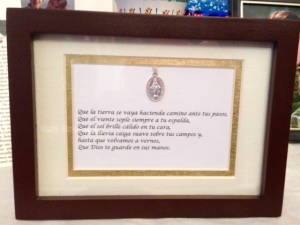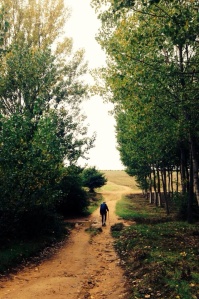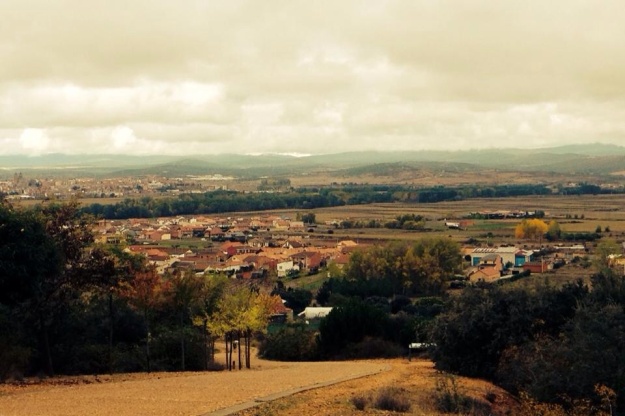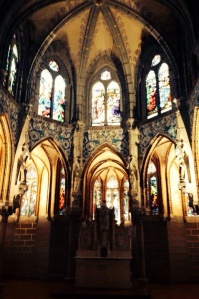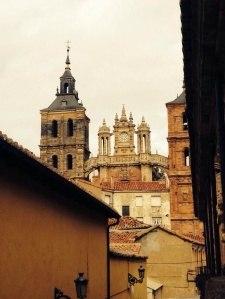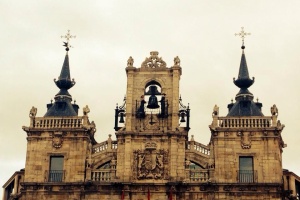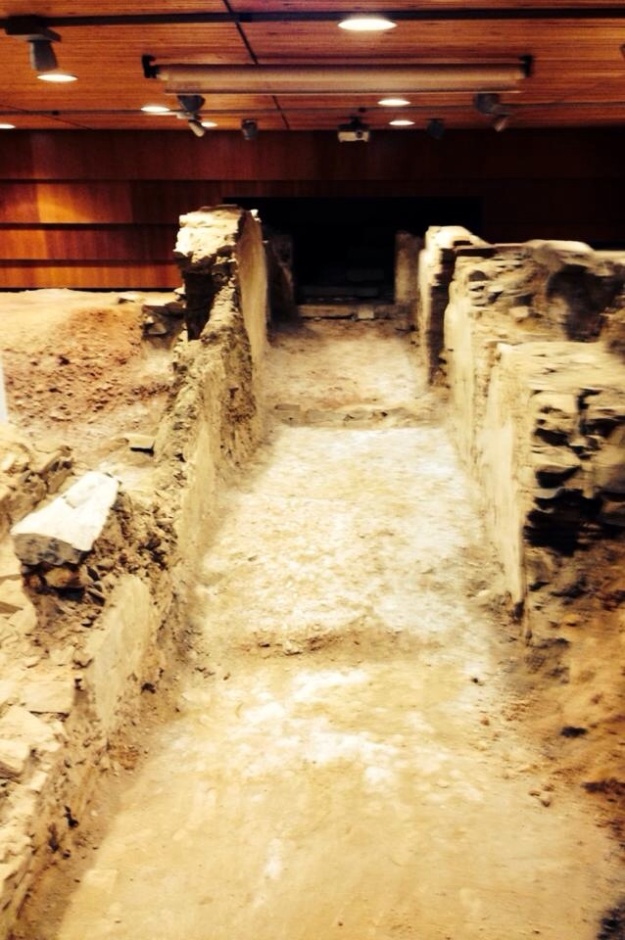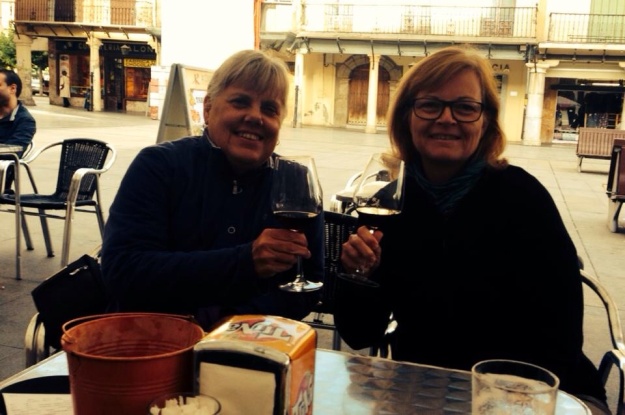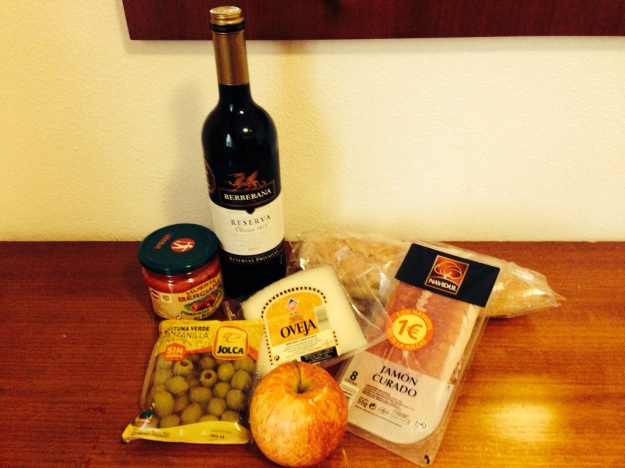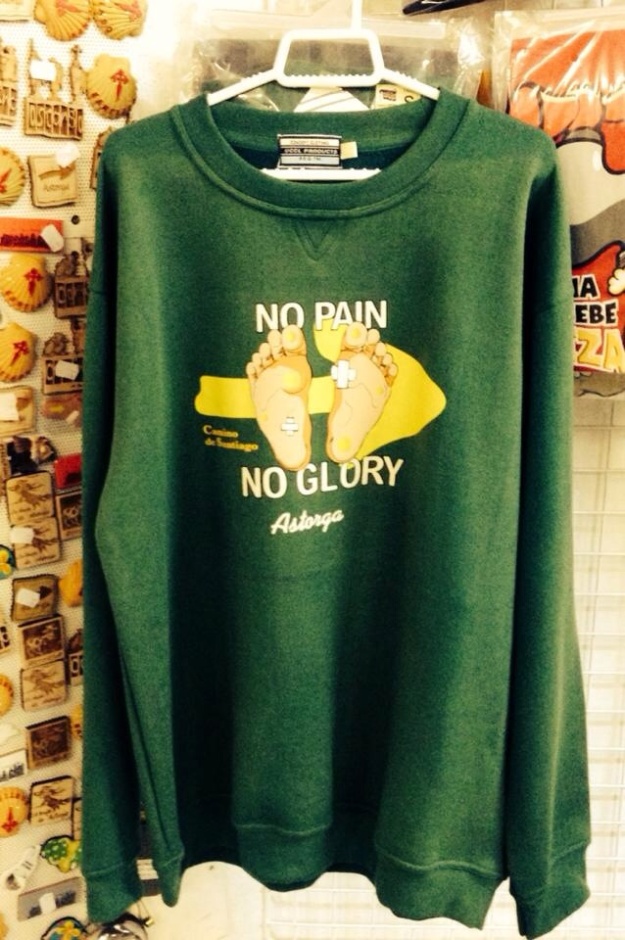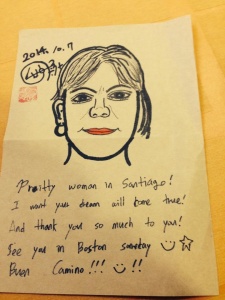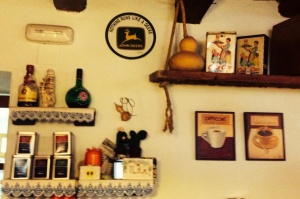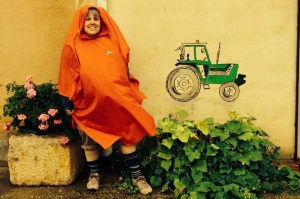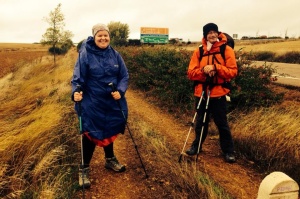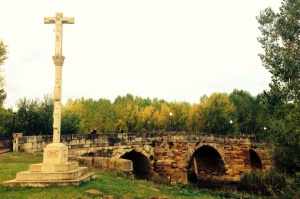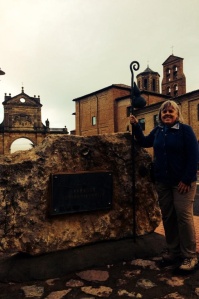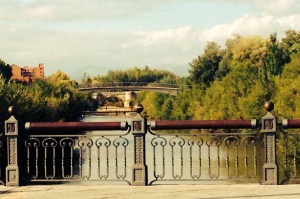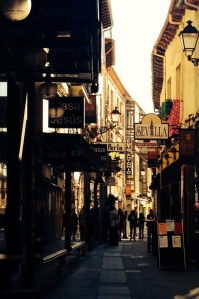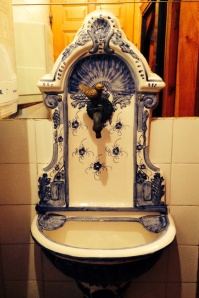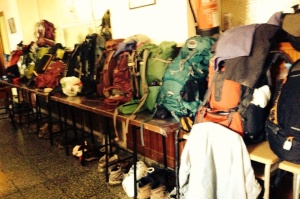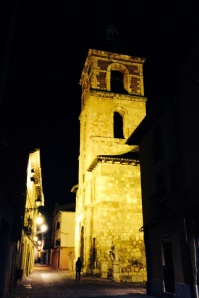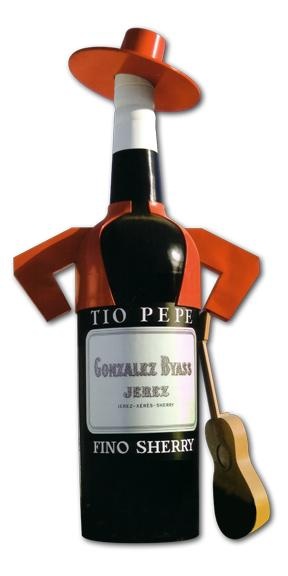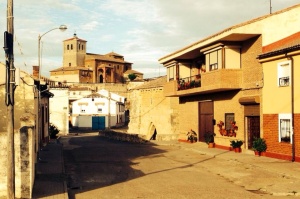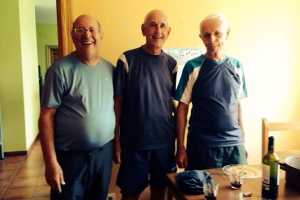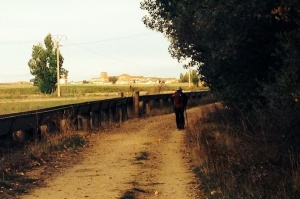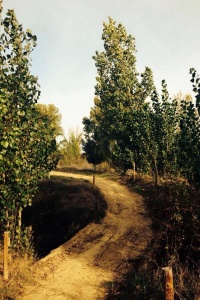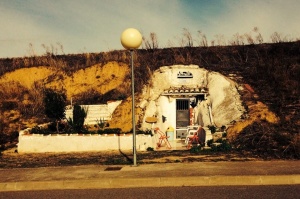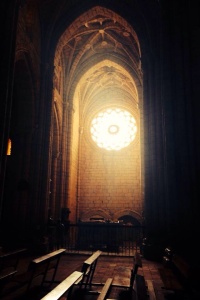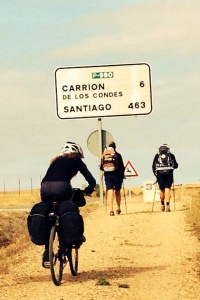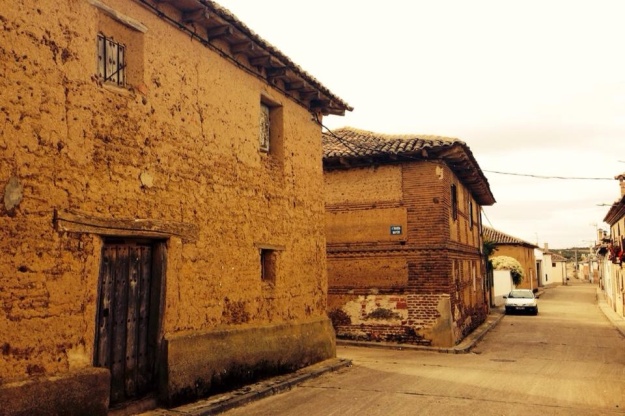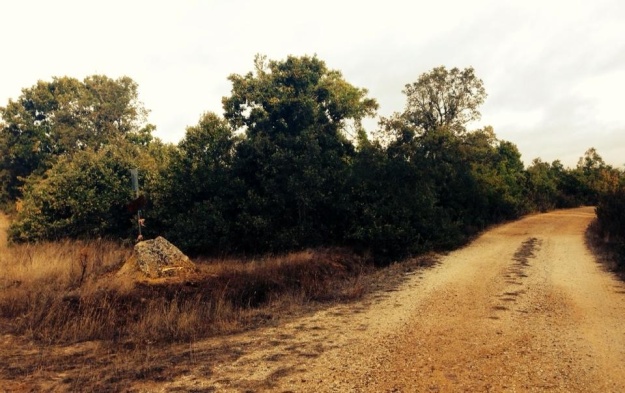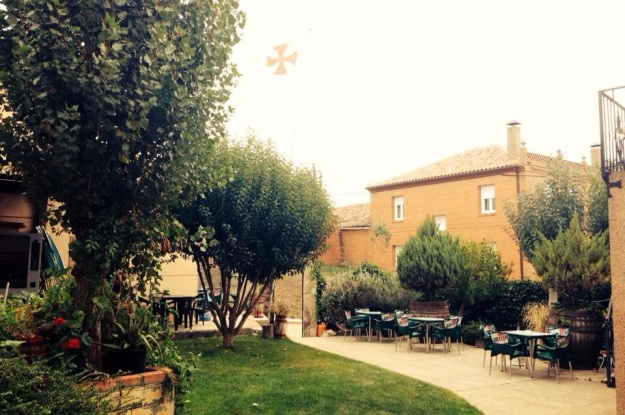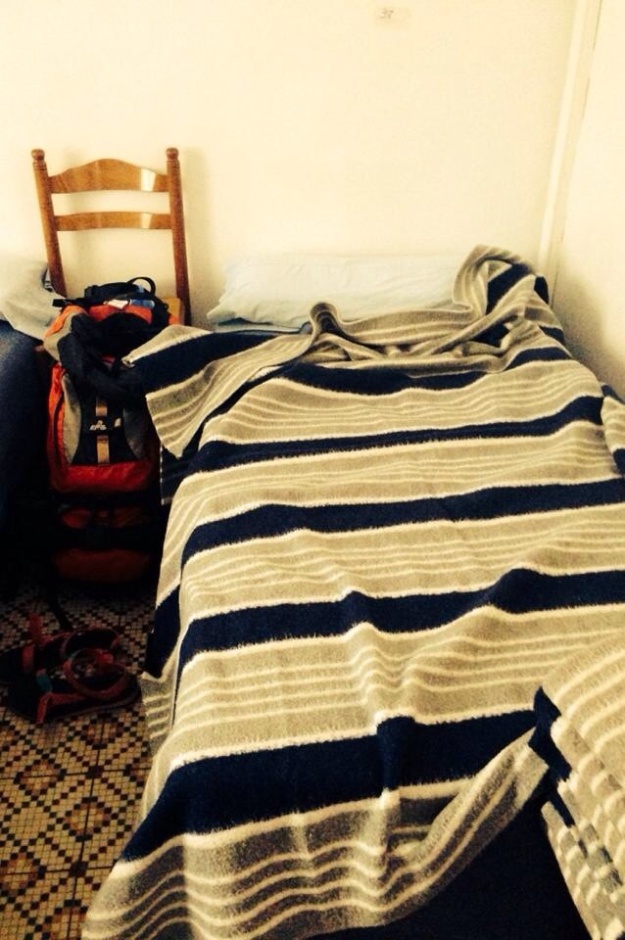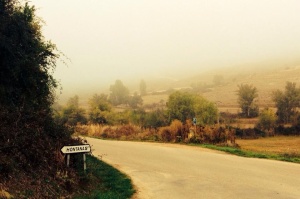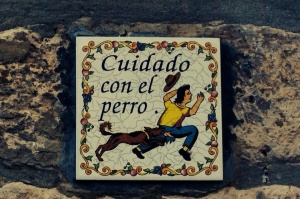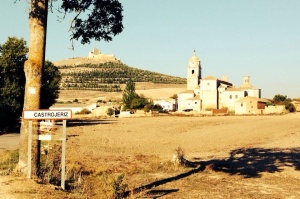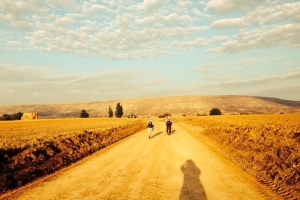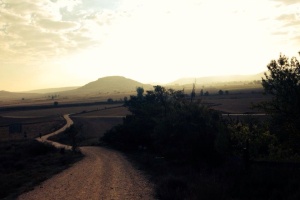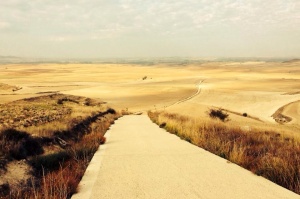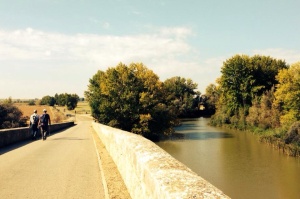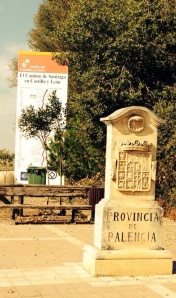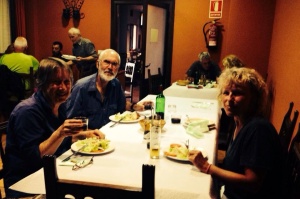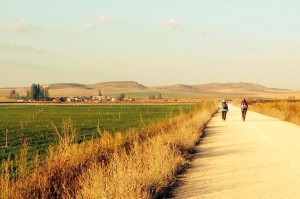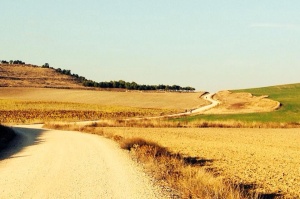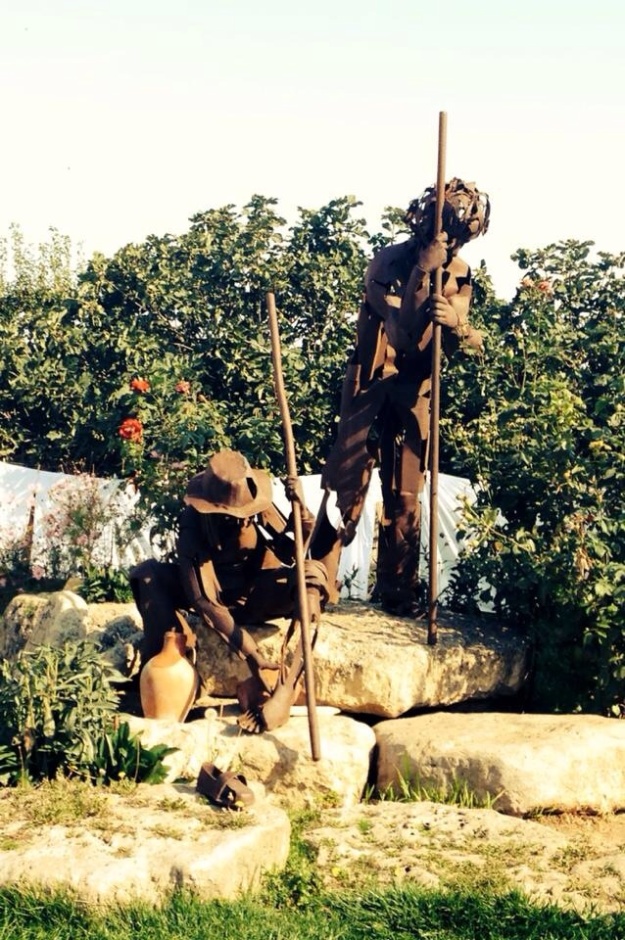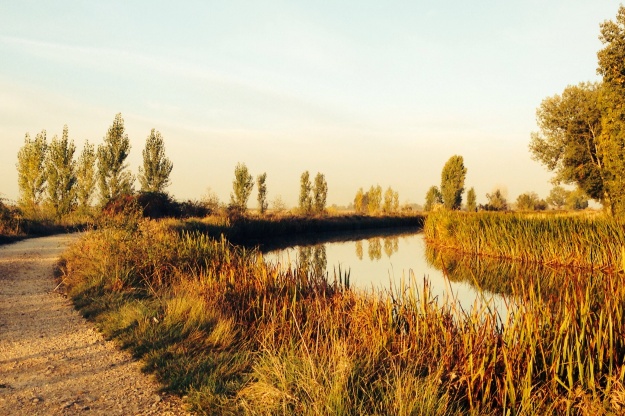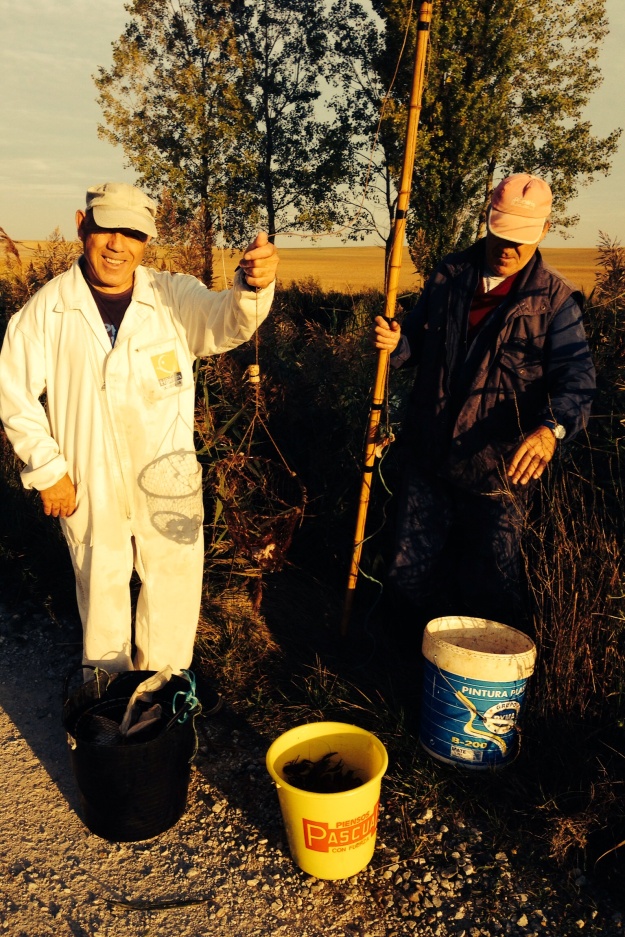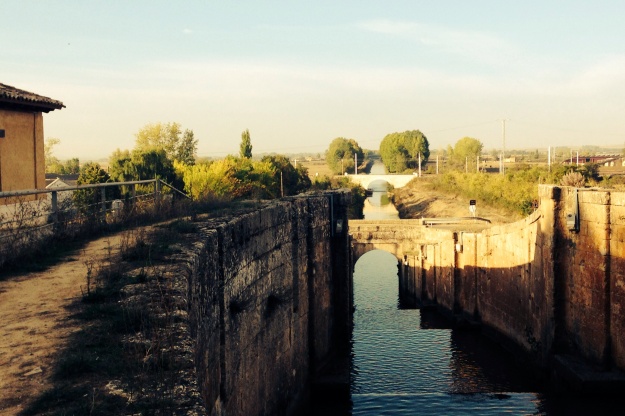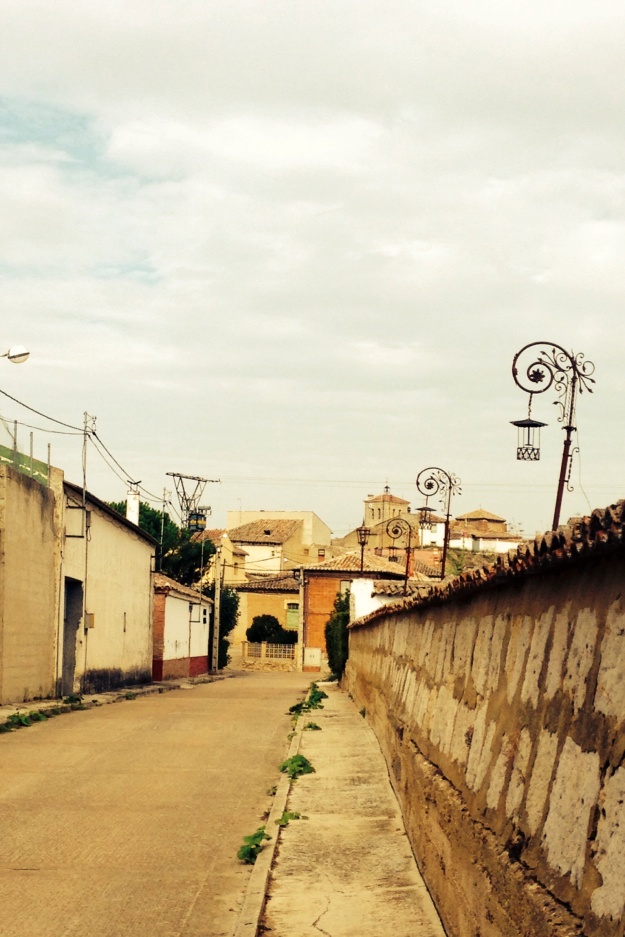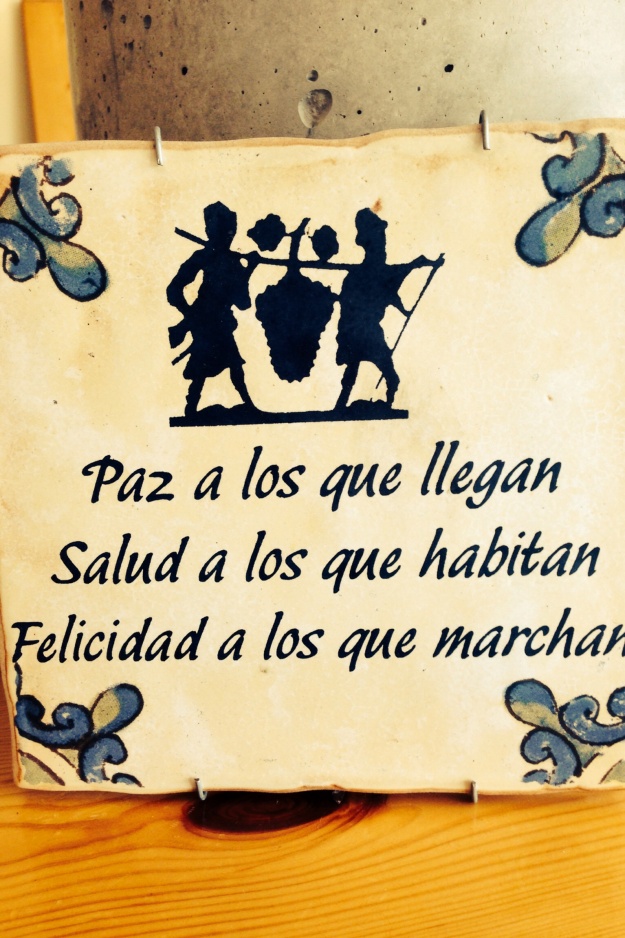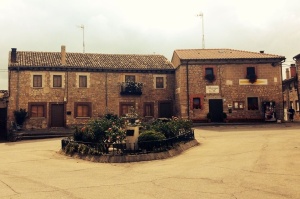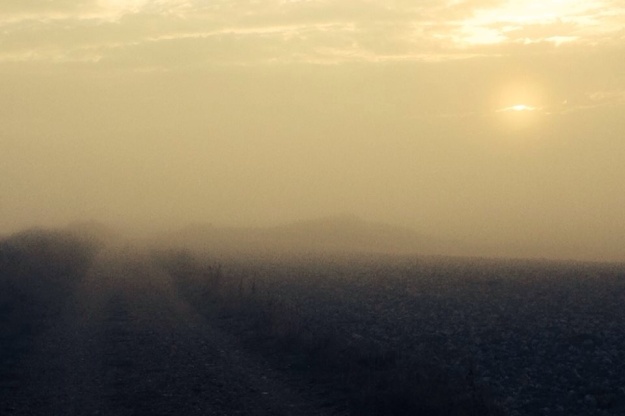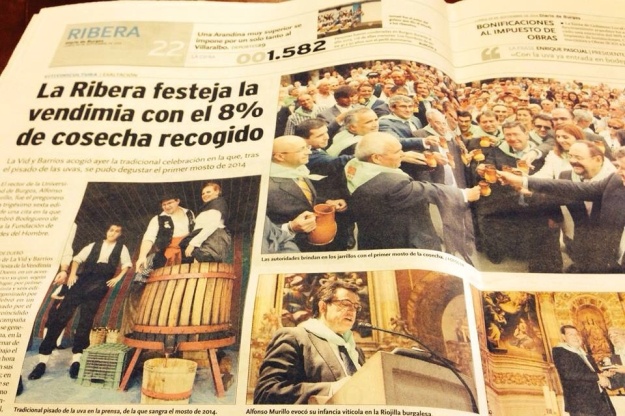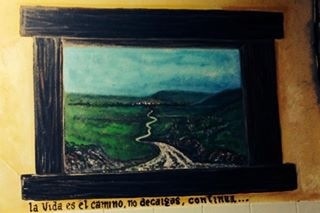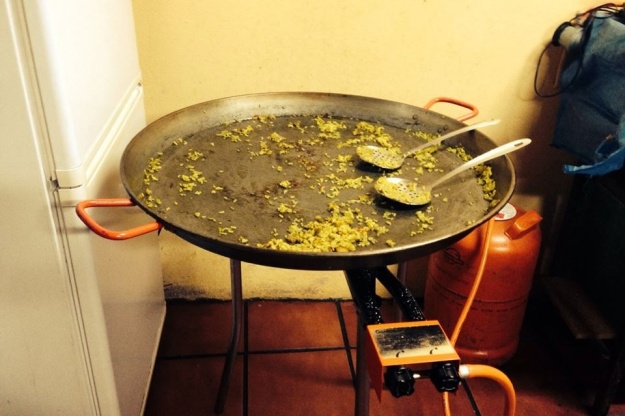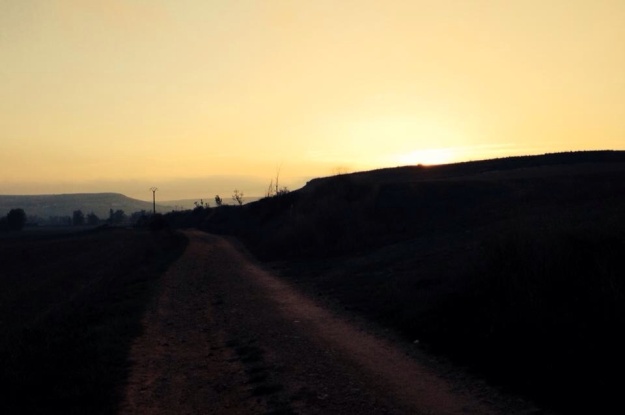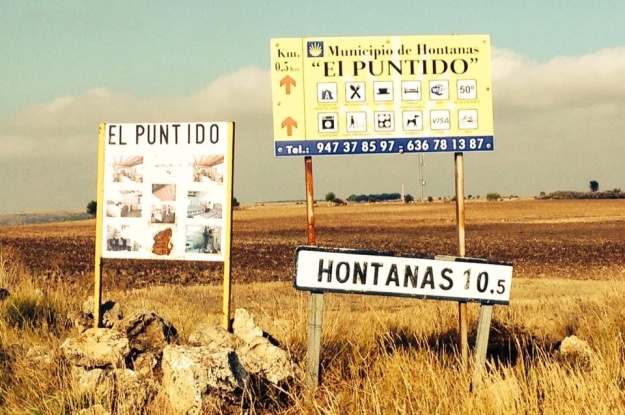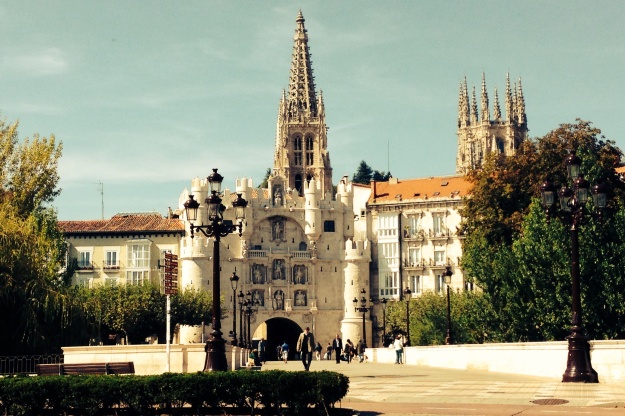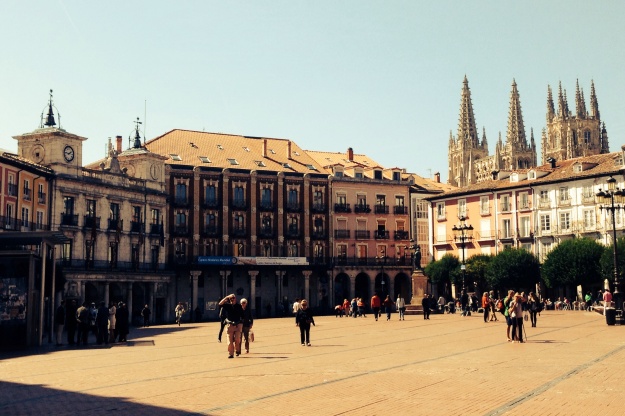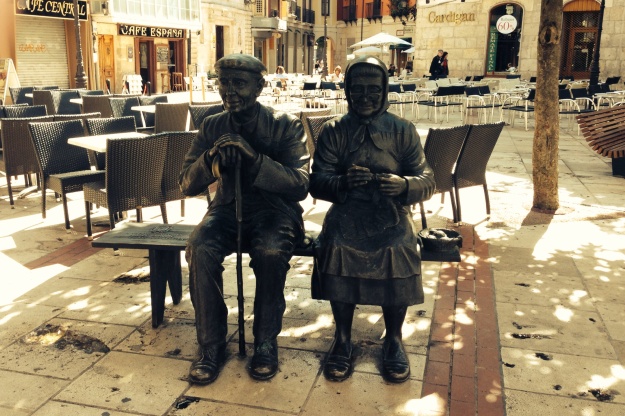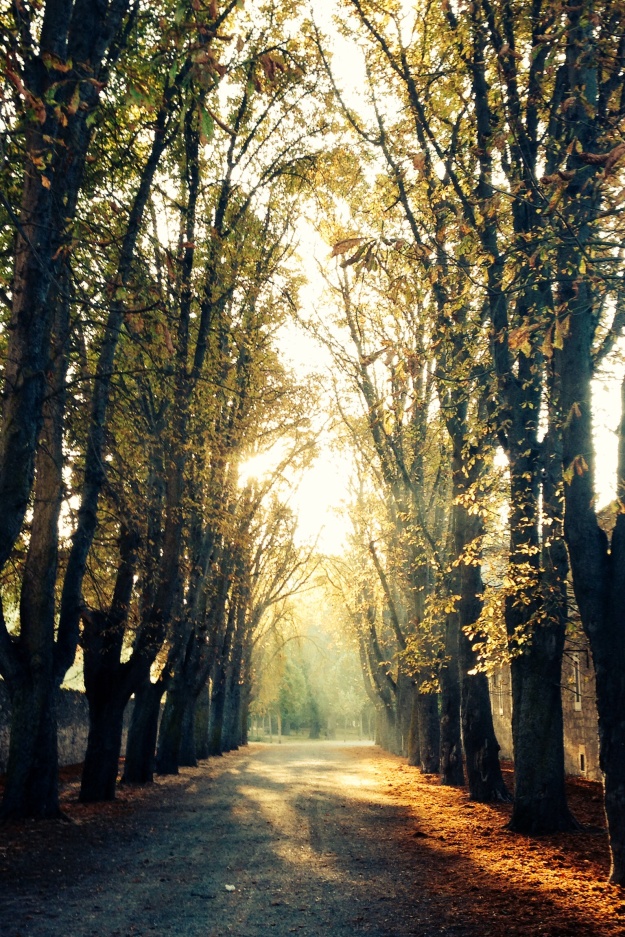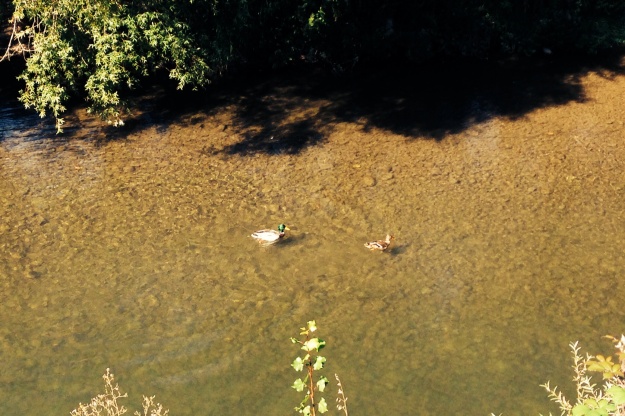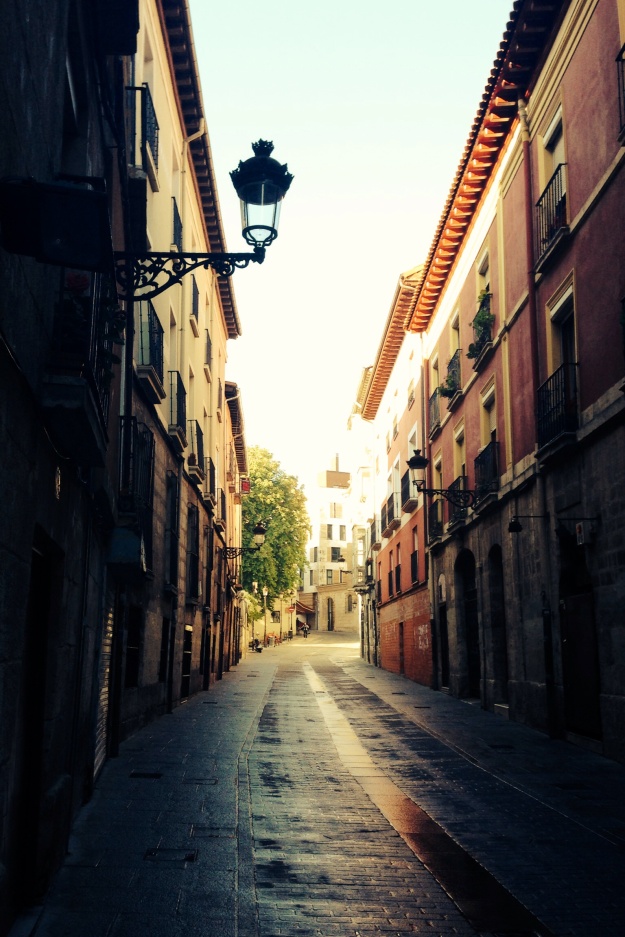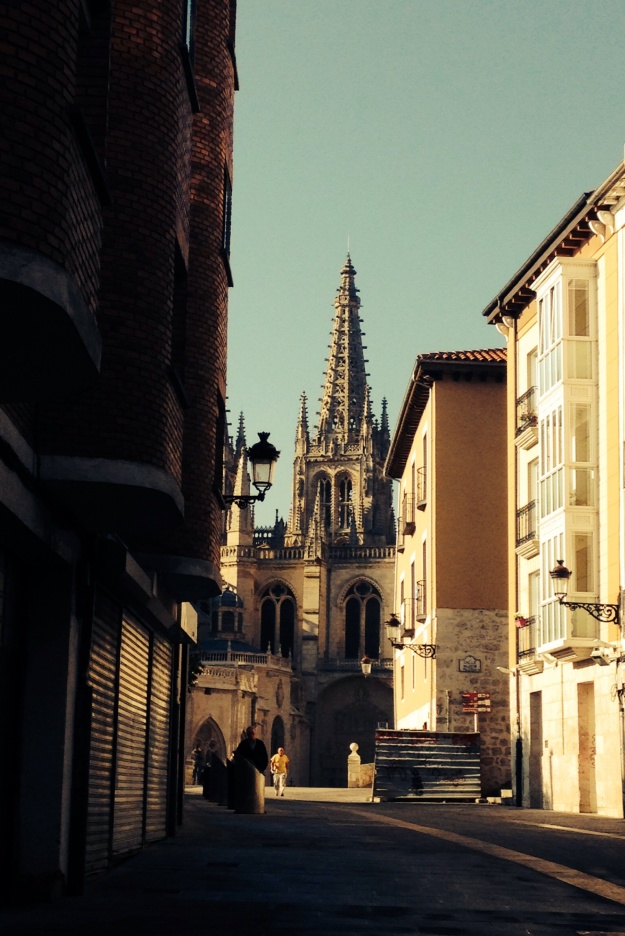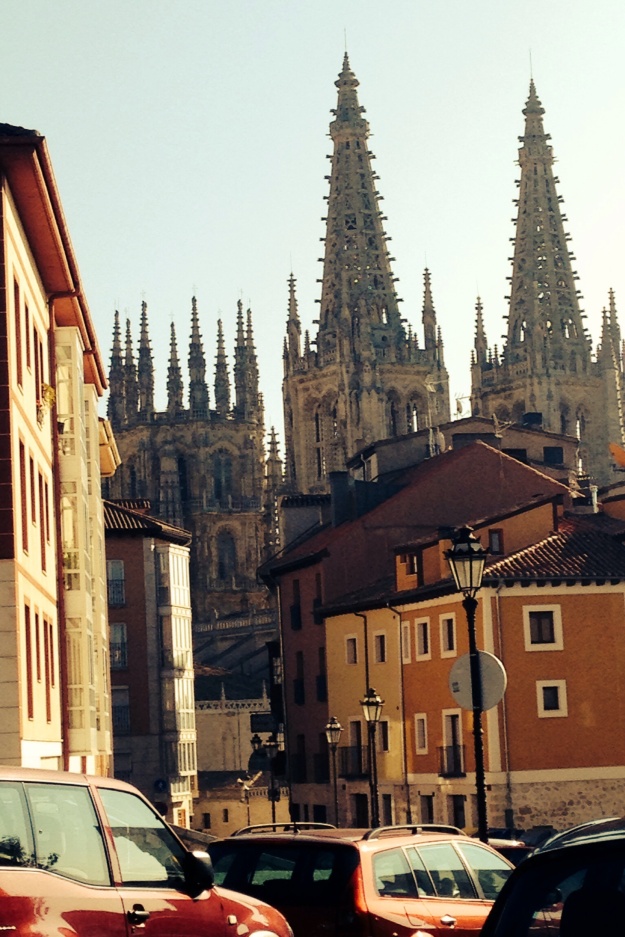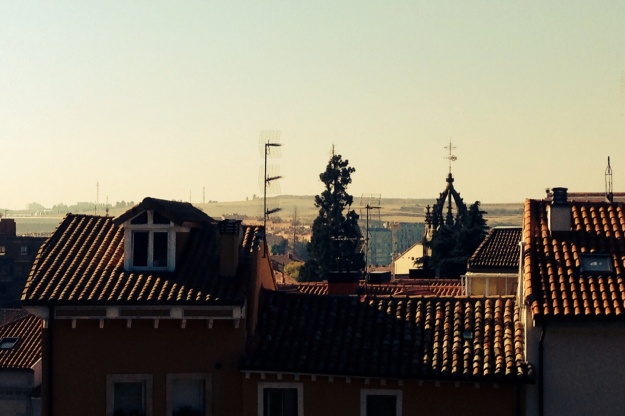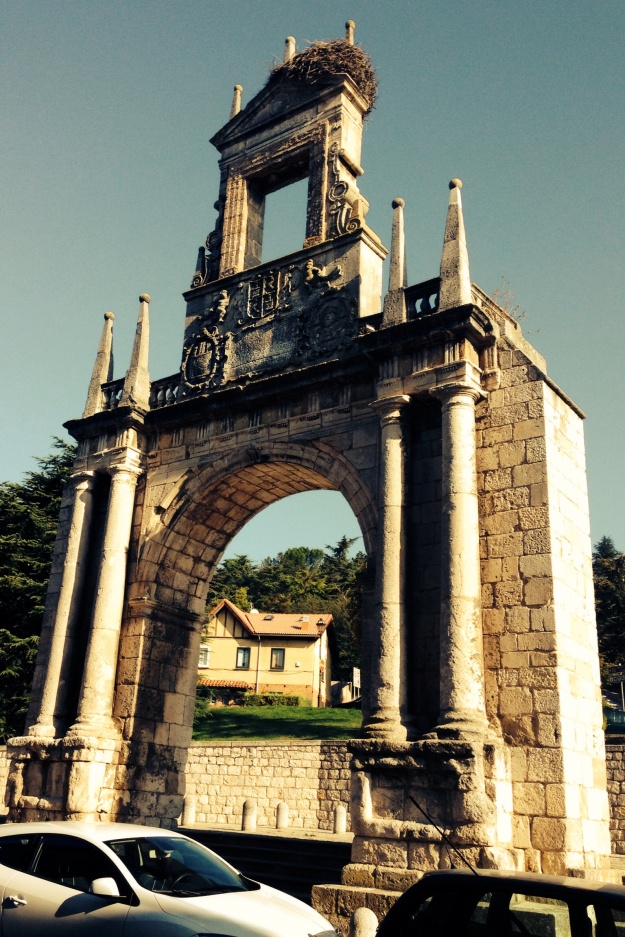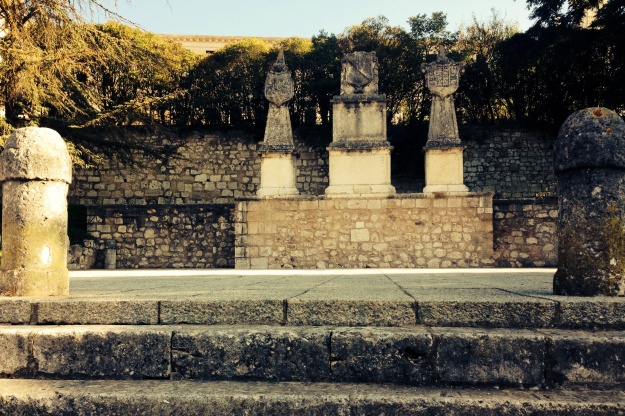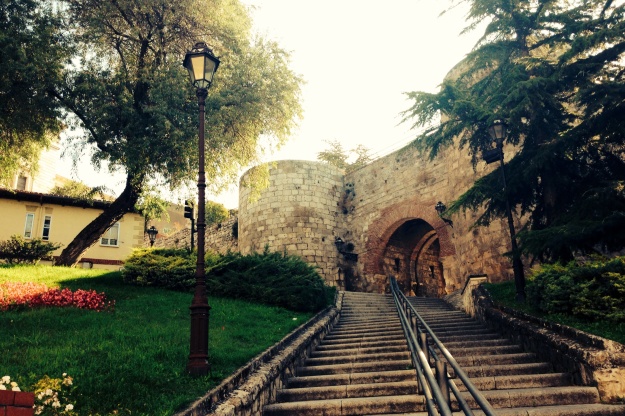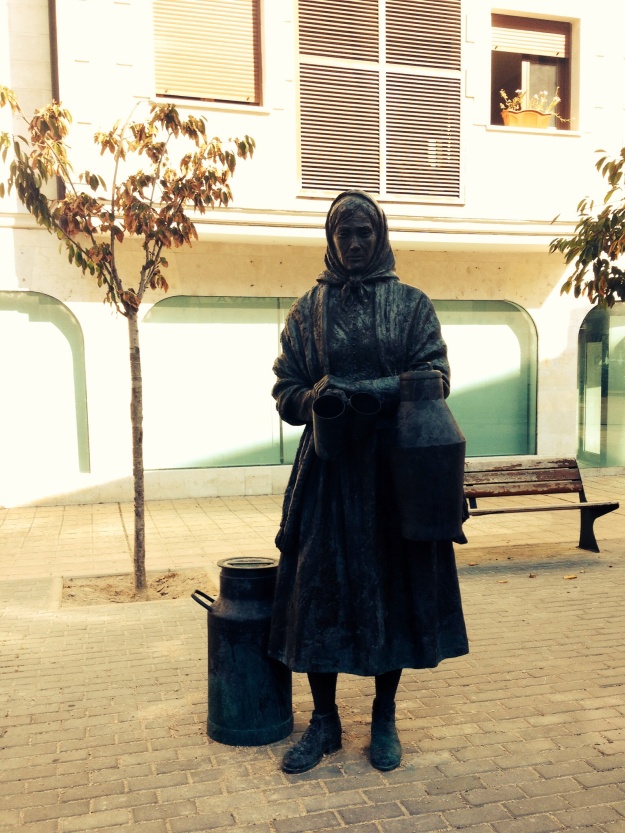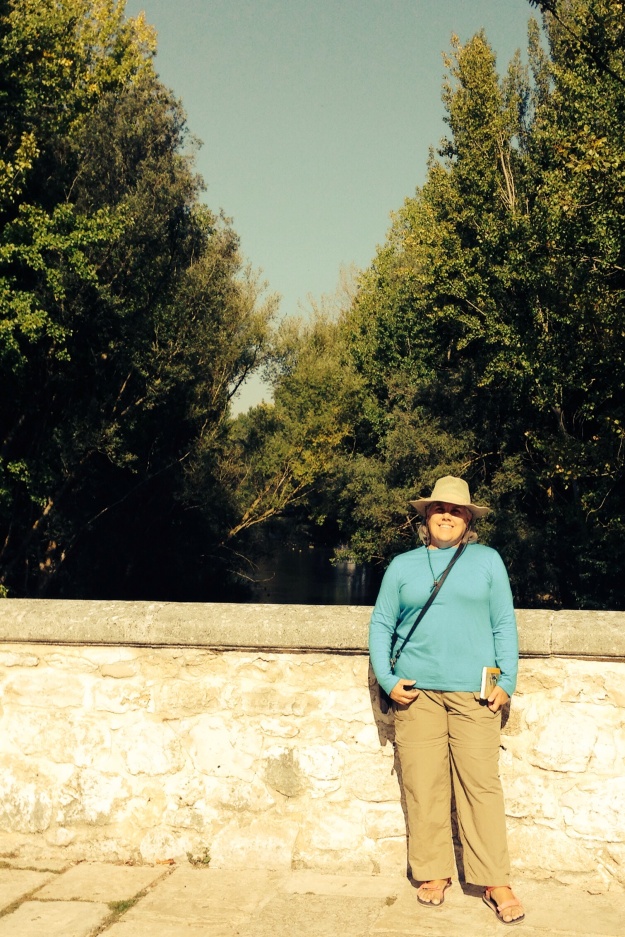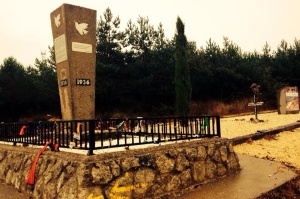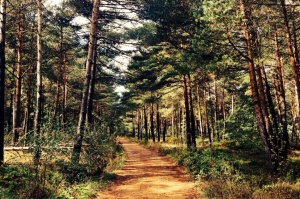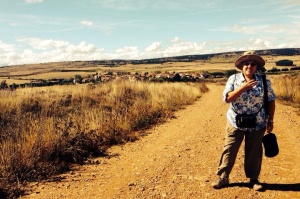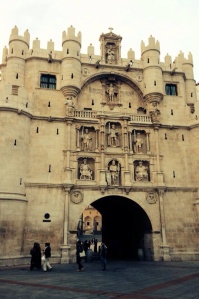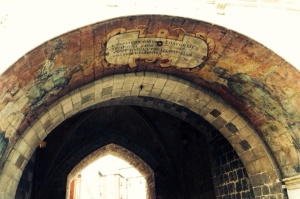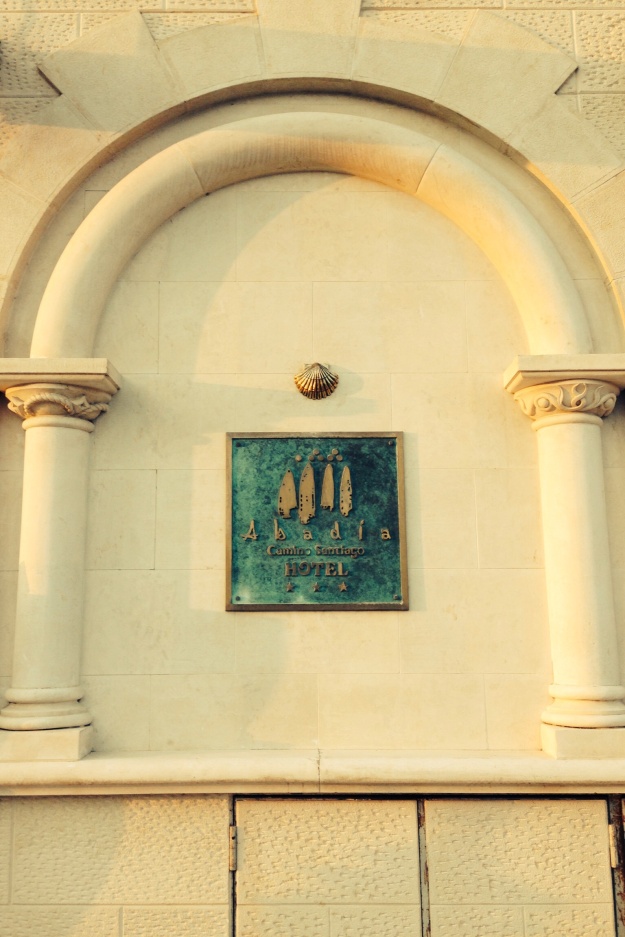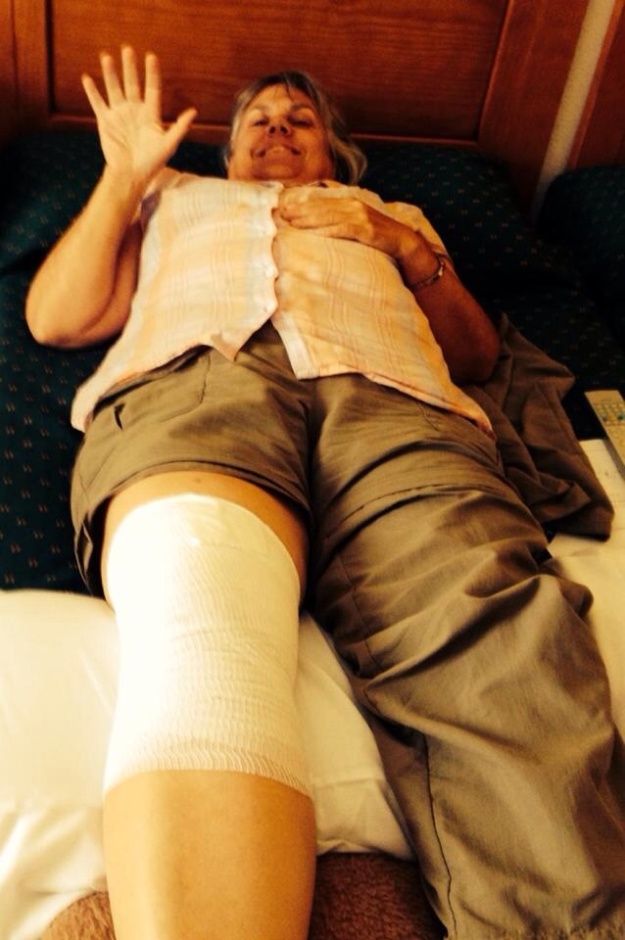A few days ago I was telling a friend about my recent adventures in furniture repair and replacement. She told me my story was begging to be blogged. Well, I haven’t had time to write it up, but I had written up another story for friends, so I posted it on a new website. If you are interested in following my new adventures, here is a link: Living in the Land of Enchantment
Camino Epilogue
A recent Christmas gift inspired me to write this mini-epilogue to my Camino adventure. I’ve been home about two months and I think I still haven’t fully processed the whole experience.
When I returned home I had accumulated a few mementos, but one was particularly dear to me. The medal I had received from the nuns in Rabé when I attended vespers there was something I wore around my neck for the remainder of my journey. Every time I met pilgrims on the road who had stayed in Rabé and attended vespers there, they were also wearing the medal they had received from the nuns. It provided something physical that served as a connection among us all. As meaningful as it was for me, I knew that once I was home I would not be wearing it, and it would probably hang in my jewelry case forever, unseen by anyone. So I gave it as a gift to a Catholic friend whom I was sure would appreciate it. And she did.
In a quirky twist, I received it back from her as a Christmas gift in a frame, together with an Irish Blessing written in Spanish (see photo). Normally one might be disappointed that they’d had a gift returned to them, but I didn’t feel that way. She confessed that she’d tried to wear the medal, but she’d had an allergic reaction. She thought that since she wasn’t wearing it, perhaps I’d like it back. But she also remembered that I had said it would likely end up unseen in my jewelry case forever. She’d remembered the Spanish translation of the Irish Blessing from my blog, printed it out, and framed it with the medal for me!
This was very touching and meaningful. Growing up as a greater Bostonian, pretty much everyone knows the Irish Blessing, whether they are of Irish descent or not. My friend who had the medal framed is Irish American. Many friends I’d met along the Camino were Irish and the blessing was printed in their Camino credential. There is a musical arrangement of the blessing that I’d once sung with an a cappella group that is a favorite of mine. The fact that it was given to me in Spanish translation at one of the albergues made a nice connection to my love for all things Spanish. And I share it with you as we all begin the new year.
Irish Blessing
May the road rise up to meet you.
May the wind be always at your back.
May the sun shine warm upon your face,
And the rains fall soft upon your fields.
And until we meet again
May God hold you in the palm of His hand.
Happy New Year!
Un abrazo, Nancy
2014 in review
The WordPress.com stats helper monkeys prepared a 2014 annual report for this blog.
Here’s an excerpt:
A San Francisco cable car holds 60 people. This blog was viewed about 1,500 times in 2014. If it were a cable car, it would take about 25 trips to carry that many people.
Final Walk, Final Thoughts
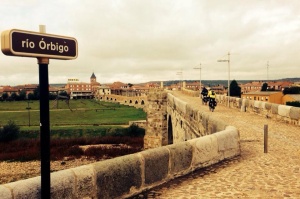
Next stop, the town of Hospital de Órbigo. Named that due to its (many?) hospital(s) attending pilgrims on their journey. This Roman bridge is the site of the ‘passo honroso’ – a knight defended the bridge against 177 lances to win his lady. Not sure what the lady thought of it all.
My last few days of walking were characterized by grey skies, damp ground, raw temperatures, and some active rain. I was lucky that on my last two days no rain actually was in the process of falling while I was walking.
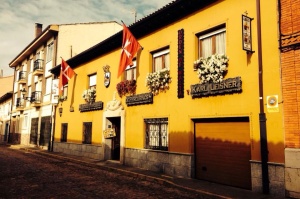
Albergue Karl Leissner – he was a priest who was a victim of the holocaust. The display in the albergue noted many valiant people for their humanitarian efforts – Gandhi, MLK, Jr., Mother Teresa, Óscar Romero.
Friends Sarah and Parke recommended Albergue Karl Lessner and I understand why. They were here in summer! It has a pretty patio and large back yard. However, on a raw rainy October day, it might not be my first choice. It would be in the 40s overnight and they deemed it too early to turn on the heat! I had a bed with sheets, a bedspread, blanket, and sleeping bag, and I needed it all!
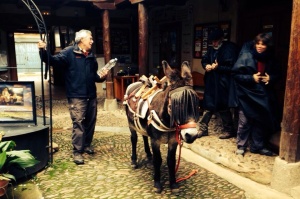
Most popular guest at the albergue who arrived with a Belgian couple – carrying their pack. He enjoyed the grass out back in a very large yard that night.
I was happy that I got to see the most interesting walker on the Camino. A couple from Belgium brought their donkey to carry their things! The man was a farrier. Donkey was a hit with the guests. Had the whole back yard to himself, although I felt badly he was out in the rain with no cover that night.
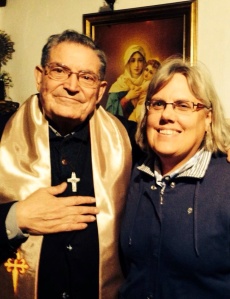
The place was run by Hungarians – no one spoke both English and Spanish. So the Spanish/Hungarian interpreter asked me to interpret in English for that night’s talk with the priest. I wonder how they usually handle this!
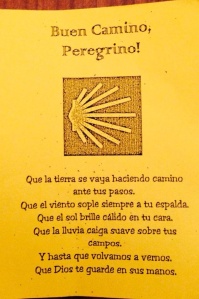
At the end of the evening they gave us these blessings, which are basically the Irish Blessing in Spanish! (They neglected to mention the Irish part)
My last day of walking I went 14 km, about 8 miles. It was wet and raw, but luckily no rain actually fell from the sky during my walk. I’d left around 7:30, made a couple of rest stops, and arrived at 1:00. I felt lucky. The landscape was beautiful in spite of the damp cold.
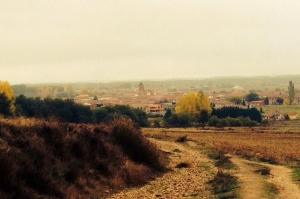
Leaving Hospital de Órbigo on my last day of walking. It was overcast, and wet and raw from the previous night’s rain but the future rain managed to hold off until I’d completed the 14 km walk
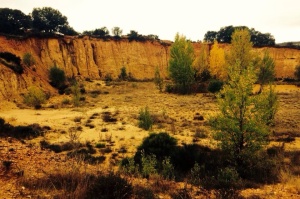
This landscape was probably the most unusual and prettiest. It was beautiful in spite of the weather
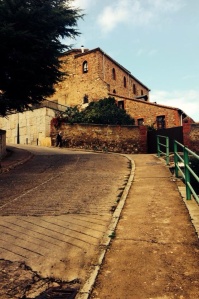
Just when I thought I was done the road had to throw in a little challenge as I approached the albergue.
I arrived in Astorga, where I planned to spend 2 nights. I had 5 nights to kill before my train back to France would leave from Santiago and I was finding that the closer I got to Santiago, the more expensive things were getting. The albergues cost 5€-10€ and the ones in Santiago would cost more than 15€! Astorga had lots to offer so it was worth spending another night here.
The first day I spent checking out the building by Gaudí that housed the Camino museum as well as the cathedral and its museum. Gaudi’s place was spectacular. The cathedral was not.
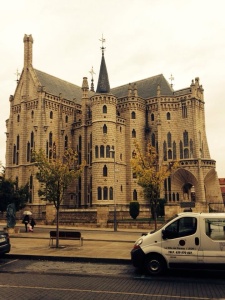
Gaudi’s buildings are always interesting. This Palacio Obispo was actually never used to house bishops. It now has a museum of the Camino inside. And spectacular stained glass windows!
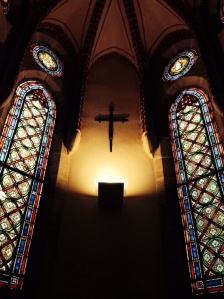
In the Camino museum is the original iron cross that was on top of Monte Irago. There is another there now, which is where pilgrims traditionally leave a rock to symbolize leaving the burdens they are carrying. (I did not leave a rock in the museum)
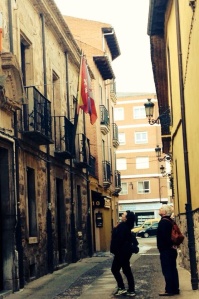
My second albergue for a second night in Astorga. We were packed like sardines in the first! In this one I was in the room with the balcony by the flags
My second night in Astorga was very different from the first – much smaller room with only a few people (6 instead of 40) in a vintage building that had been nicely renovated. Great indoor public area and outdoor patio. Great shower, toilet, sink facilities. (These things really matter) Unfortunately since I was in the original part of the building the floors and beds creaked more than any other I’d used, and the heat was not the greatest. My laundry didn’t dry, so was transported in a plastic bag to Galicia on the train!
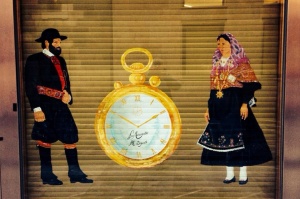
It’s all about the Maragatos in Astorga. They are the isolated hill people of the region and their origins are uncertain. Some think the name comes from King Mauregato and the Visigoths of the 7th century.
Now, I may not be walking all the way to Santiago, but I did have prayers to deliver. I hope the fact that I took the train there from Astorga didn’t invalidate those prayers!
There is only one train each day to Santiago from Astorga (without connection) and it leaves at 3:15 in the afternoon. I had most of another day to kill since we had to get out of the albergue at 8 am! And now it was raining -steadily! Aside from breakfast places, nothing opens until 10:30 – a lot of time to kill in a town you can walk through in a half hour.
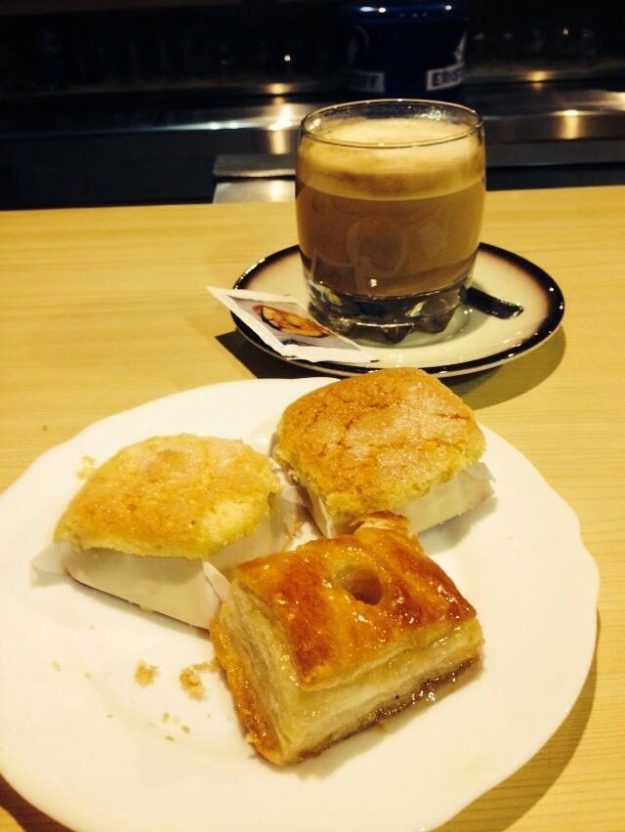
For my first breakfast that day I indulged in Maragato pastries – 2 mantecadas and an hojaldre. There are places that make these pastries on EVERY block in Astorga!
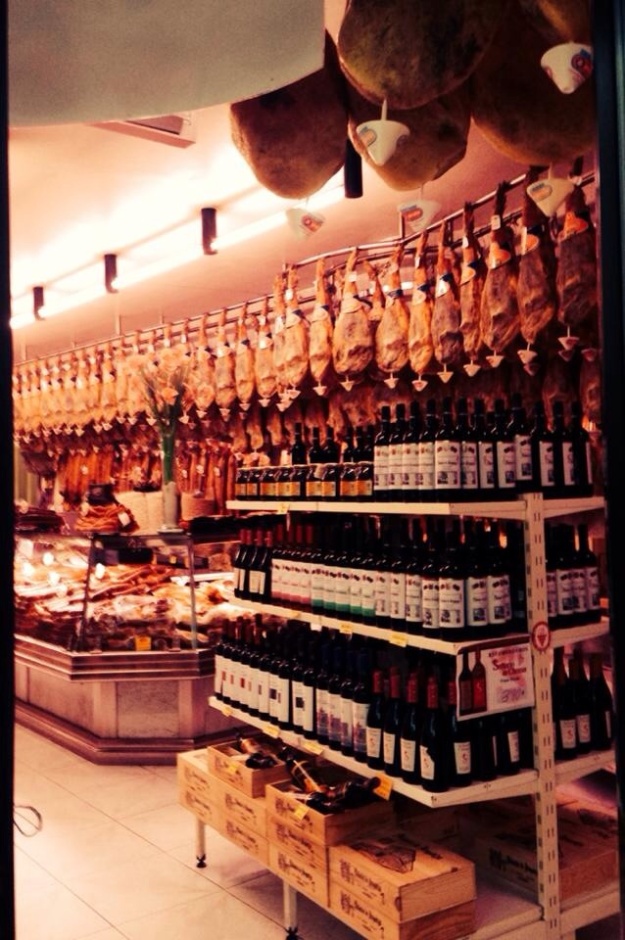
There may be mantecada/hojaldre makers on every block, but there are shops selling hams and local cold cuts on every other block! The local specialty is cecina, a goat meat. Some guys from Toledo wanted me to try it but they were all out. I enjoyed avoiding the rain in this doorway while I waited for second breakfast!
It was 9:45 and I’d eaten my Maragato breakfast at 7:30. I thought it was time for some protein so ordered some scrambled eggs with ham and OJ as I waited for the Museo Romano to open at 10:30.
It is believed that Astorga was originally settled as a Roman encampment to control the mining interests of the area. I was going to the museum primarily to kill time, and it turned out to be well worth the time I spent. I arrived as it opened and learned that at 11 I could do the ‘ruta romana’ tour. They take you underneath a number of buildings to show you roman ruins. These are apartment buildings or public places that are required by law to preserve ruins if they encounter them when excavating for a new building. As a result of losing basement space, the architect is allowed to build an extra floor on the building.
I was the only person on this tour. Thank the Lord I could speak Spanish as it was not available in English. It was one of the most fascinating parts of my entire trip. She said she has 50-100 people some days but the rain was probably keeping people away. Did I luck out, because the sun managed to come out briefly during our walk!
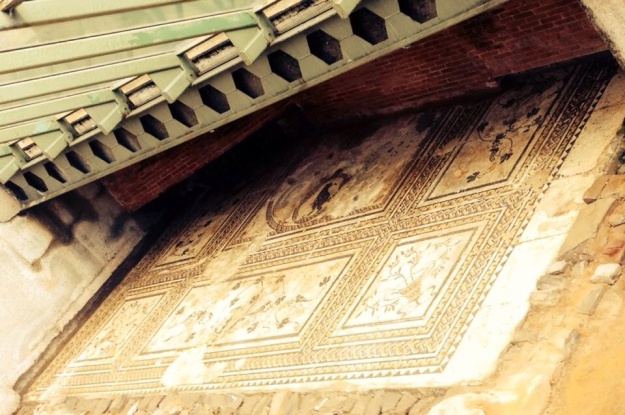
Mosaic floor from the home of a prominent family of Roman times. The designs are interpreted as preoccupation with the physical and spiritual
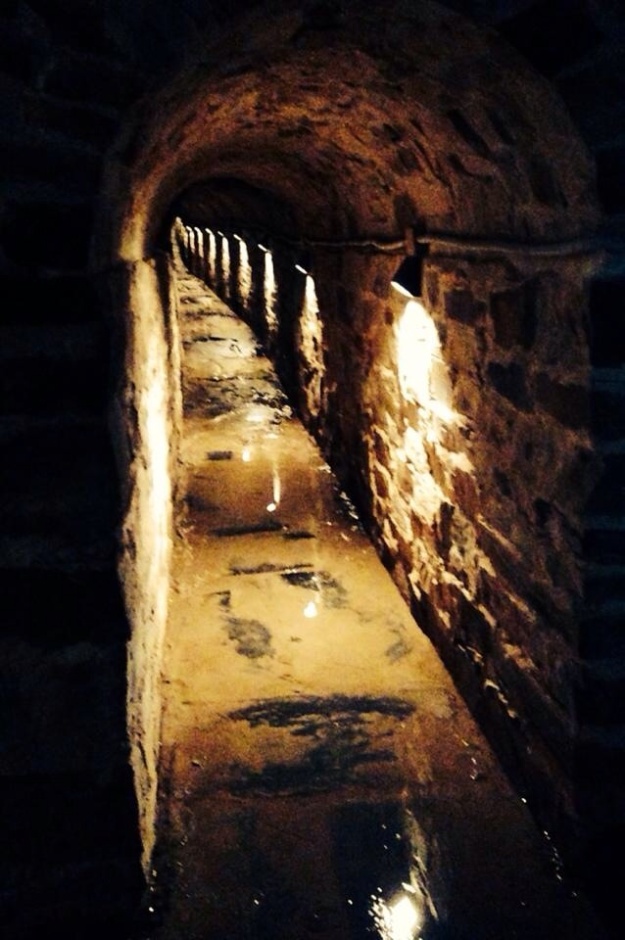
Yes, we walked the entire length of this Roman sewer, which is actually full of rainwater from all the recent rain. Other parts of the original Roman sewer are still being used by the city today
At the end of the tour I went to collect my pack and grab an ensalada mixta before heading for the train. Claudia, from Aachen, Germany was at the restaurant. We’d been meeting along the road and she’d be returning home the following day. I find it interesting that most of the people I connected with best on the Camino are people who didn’t finish it – at least not this year!
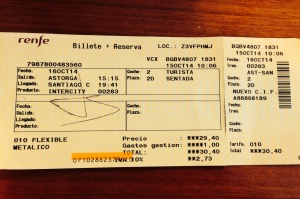
There is more than one way to get to Santiago. My first time was hitch hiking, second by rental car, and this time was by train – not quite what was planned, but it gives me an excuse to come back. Hopefully next time will be on horseback!
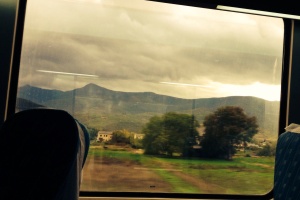
It rains a lot in Galicia. But as a result I think it is the most beautiful countryside in Spain (maybe my Scottish/New England roots favor green)
I got into Santiago after dark but luckily my hotel was only a two-minute walk from the train station. Since I would be paying over 15€ for an albergue, I figured why not pay 30€ and spring for my own private bath! The days of sharing my bedroom and bathroom with strangers are over!
I spent my first of two days in Santiago resting, recuperating, and reorganizing. No sense fighting the wind and rain to get to the cathedral when I had another day ahead of me (which was predicted to be better). I went food shopping and had my laundry done. And the hotel even has a hair dryer I can borrow!
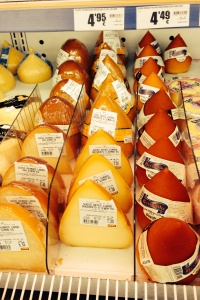
Typical tetilla cheese from Galicia. I’m guessing even those of you who don’t know Spanish understand what that means
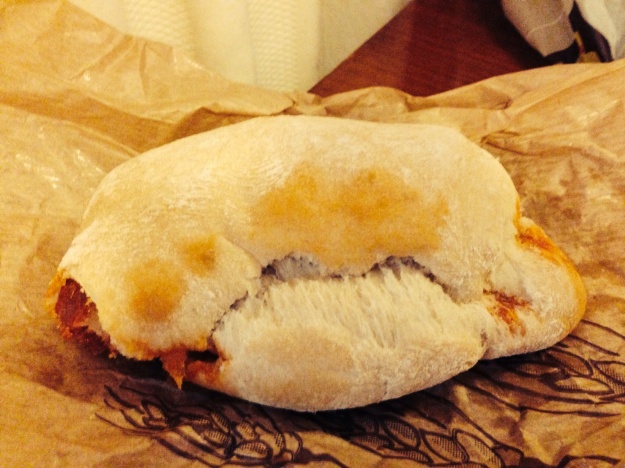
I asked the woman at the bakery to recommend a typical Galician snack that I’d eat for lunch – she suggested a prenyada (pregnant). Galicia seems to be very focused on women’s bodies
So what did I learn on my Camino? My favorite line from the documentary “Walking the Camino: Six Ways to Santiago” was: ‘If you go to Santiago looking for Him, He will not be there. You bring Him with you.’ That is to say that I’m not sure I learned anything completely new. Perhaps some old lessons were reinforced, with a few surprises thrown in.
1. There are good and bad days. I had more fun than I imagined with some people. And surprising altercations I could never have predicted with others. Some events were hilarious. Others were quite sad. For me personally none of it was worth crying about – even my knee pain and loss of toenails!
2. We are social creatures. Brierly suggests unplugging on the Camino, but I want to share with people – even those I know at home. And connecting with home was very sustaining for me.
3. Blogging is not very satisfying. It is like giving a presentation, as opposed to having a conversation. As unsophisticated as it seems, I prefer FB. More people there are inclined to dialog with you, which is a lot more satisfying. Thank you Pat, Helen, and Sandi for your consistent e-mails that let me know someone out there was still caring about what I was writing! (Maybe this was a new lesson since I’d never blogged before) It’s also particularly challenging blogging on an iPhone, but I’m happy I didn’t carry anything heavier!
4. We are more inclined to observe than get involved. This echoes #3 at a deeper level. And I already learned that from my time spent on FB.
5. Everything happens for a reason/It’s about the journey and not the destination. Basically had I not gotten tendonitis, I think I would have had a less satisfying trip. It made me slow down, see more, learn more, connect more. I didn’t get my compostela, but I did get the possibility of finishing this thing on horseback, which I’ve wanted to do.
6. No one is going to slow down to join you if you’re only going 10km per day, no matter how interesting they think you are. We all have schedules to keep and our priorities on the road. But someone else always comes along to connect with. This is the lesson that perhaps sticks with me most. I’m usually the goal-oriented one who’s rushing around, but I couldn’t be that once I got tendonitis! It makes me wonder how many people we all leave behind each day.
7. It’s possible – and maybe not that difficult – to create a new normal in your life. Had my leg held up, I would have walked 20 km (12 miles) a day. That is the amount that felt right and took an appropriate amount of time. It felt pathetic walking only 10 km/6 miles! It’s hard to believe that walking 12 miles a day would feel good to me. It’s certainly nothing I’ve ever done before!
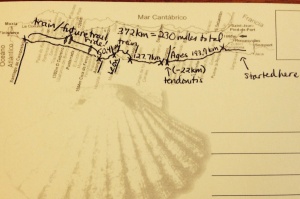
And my grand total was 230 miles. At least now I won’t be disappointed I didn’t complete the Camino on horseback.
And tomorrow I will visit the cathedral.
Miracles Among the Raindrops
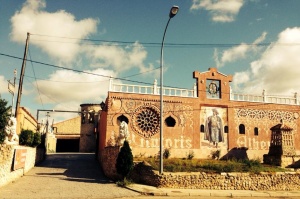
My next stop was this hotel/albergue complex in Sahagún. Nice place, though when I arrived it was pouring rain
The evening I spent at Jacques de Molay’s in the land of the Knights Templar was quite unexpected. The albergue is the only one in a town in the middle of nowhere. It was packed! Dinner was to be served at 7 and people were crowding the dining room at 6:30. At 6:50 I thought I’d check things out. I arrived just as the innkeeper was kicking everyone out, saying she needed 10 minutes without interruption so she could prepare dinner! I looked at the crowd and the number of tables and wondered if I’d have a shot at getting a seat for dinner. The whole situation was chaos, but luckily they had a small grocery store. I decided to do a bread, cheese, olives, night. It would have been nice to go out but it was cold, threatening rain, and probably there was no place else in town anyway! There was a nice sitting room with tables near my bedroom. I would have liked some red wine, but didn’t want a whole bottle to myself, so picked up a juice box!
I entered the room and shortly after two 20ish Korean girls arrived with the wine I wanted. I shared my cheese and they shared their wine. Miracle #1: wine on demand in an appropriate quantity!
One of them spoke English and became interpreter for our conversation. I asked them why there were so many Koreans on the Camino. Well, it turns out a Korean woman walked it several decades ago and was so inspired that she created a trail half the length in Korea – the Jeju Trail. See the link for details:
http://en.m.wikipedia.org/wiki/Olle_road#undefined
These two had met on the Jeju Trail and had worked in the inns, saving their money to make the pilgrimage to Santiago. They thought it was more beautiful than the Camino de Santiago. (Given the pictures they showed me, I’d agree) I asked if they were disappointed and they said no, it was just very different.
One of them had gotten into drawing while working Jeju and asked to draw my portrait. I learned that the other would be traveling to Boston after Santiago to visit a cousin who owns the Bonchon Restaurant in Allston! I gave her my contact info and said to get in touch while she’s in Boston.
The next morning I left for Sahagún. I knew I wouldn’t be seeing the Koreans there since they claimed there were bedbugs in Sahagún and they were planning to skip it. I thought the place I stayed was quite nice and I’m pretty sure I didn’t pick up any bedbugs!
I ended up walking to Sahagún with Kathleen, a dual citizen Canadian/American who lived in Montreal and Antoine from Switzerland. It was a disgustingly rainy day, but the worst part was the wind, that was nearly blowing people off the trail!
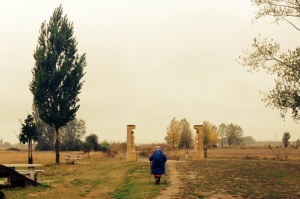
Shortly after we entered León province we saw these two pillars. They are the halfway marker for the Camino francés. If I were going to finish I’d be halfway there!
We all went our separate ways in Sahagún. Kathleen was planning to spring for a pension that night and I couldn’t get into an albergue fast enough. I went for the first one as we entered town (first picture above). It was a nice hotel-albergue complex with a dining room – no need to go out in the rain again!
According to the weather forecast I saw, the following day was supposed to bring more rain. I’d just completed 200 miles of walking and decided it was time to take the train – to León. What would be a 3-day walk would take 35 minutes! I spent the morning seeing Sahagún with John from Utah and a woman from Hungary as they walked on. The day was clearing up – did I make the wrong decision? Oh well, I still got to see the countryside from the train and skipped walking through the industrialized outskirts of León.
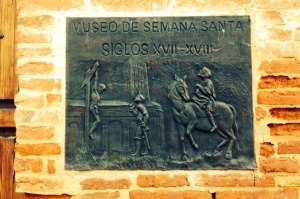
Since I was trying to kill time in Sahagún, I thought I’d see the Semana Santa museum. It was supposed to be open at 11. I was there at 11:30, but no luck. Maybe the schedule on the door was just a suggestion!
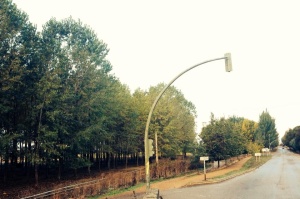
Just beyond the Roman bridge was this poplar grove – they supposedly sprang from the lances of Charlemagne’s men
I arrived in León on what turned out to be a sunny afternoon. Since I now had extra days I decided to spend 2 nights in León. The two albergues I stayed in could not be more different!
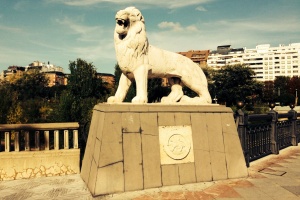
This bridge into León over the Bernesga River has 4 lions standing at its corners. León means lion but the name of the town is actually derived from the word legion. There were legions of soldiers defending the king at some point
The first night I spent in León I was in what appeared to be a university residence/albergue complex that seemed to support the local handball team. (Handball instead of football/soccer, but basically the same game) It was a high rise modern building with only two others sharing my room for six. We had our own bathroom. The hours were the most lenient I’d seen – doors closed at midnight and you didn’t have to leave til 10am (8 is the norm).
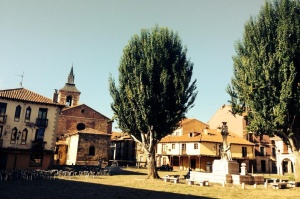
Plaza Santa Maria de Carabajal – the albergue run by the Benedictine nuns is on this square in the old city
The next day I checked into the albergue run by the nuns in the old city. It actually seemed to be run by a cadre of French volunteers who ran it like the military. Lots of order put in place, including exactly which bed in which room you’d be sleeping in! Most places would let you spread out if they weren’t full – not this place! They’d fill one room at a time so they didn’t have to clean them all if they didn’t fill up! They were kicking us out at 7:30 the next morning while it was still dark when they said we could stay til 8am! I’d never seen so many beds packed in a room! The one positive was that this was the first place with an all women dormitory.
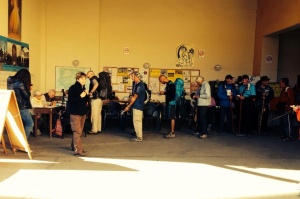
The line to get into the albergue run by the Benedictines. They had separate dorms for men, women, and couples. It housed more than 100.
The most memorable experience I had at this albergue was meeting a vet from Brazil who specialized in horses. (He told me he wouldn’t even work on his own dogs – took them to their own vet!) I was flattered that he thought I was Spanish when he heard me speak (clearly he was not a native speaker!) He was 49, married, two kids, and told his wife he needed a month to do this since he was about to turn 50! Although he was a vet he taught at the university so could arrange his classes to take some time off. I told him I was about to turn 60. The Danish woman at the table with us was 72!
He had studied breeding in Wisconsin and spoke good English. He also spoke Spanish. Turns out he was a travel junkie who had backpacked South America and Asia in his 20s. He told me about a young Spanish woman riding the Camino on horseback with her dog trailing along. He’d met her in the city of Logroño when the pavement was wet and the horse kept slipping and falling. And the dog was barking. And the crowd was gathering. He helped get the horse to its feet and stabilized it against a wall. He said it only had skin abrasions – no major injuries. He showed me a picture he took. Who would think that in the middle of the city that a rider in need would have a Spanish speaking vet who was an equine specialist right by them? Miracle #2!
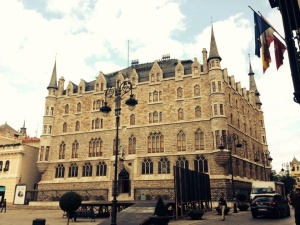
Casa Botines is a building by architect Gaudí that was a first – funded by publis instead of church funds
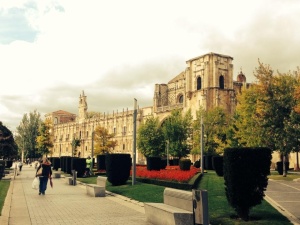
The San Marcos monastery is now a parador – high end hotel by the Spanish government in typically historic buildings
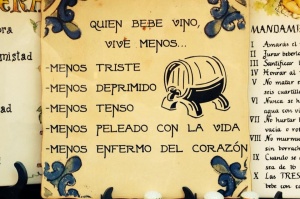
In a shop in León: He who drinks wine lives less Less sad Less depressed Less tense Less fighting with life Less heartsick
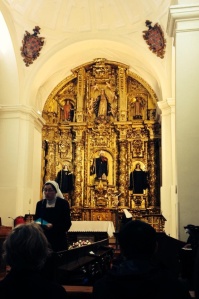
At the nearby church the nuns had a vespers service with communion. They had participants read parts in their native languages: Spanish, English, French, Italian
I didn’t get far that next day – about 8 km to the suburb of Virgen del Camino. Given that I didn’t want to walk much more than 10 km I had to be strategic about where I’d stop. The next day I’d be doing 13km. The albergue was the most comfortable yet – dorm for a former seminary with lots of lounge space and a big kitchen. Too bad the surroundings were not all that appealing!
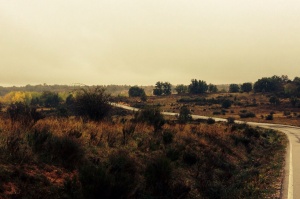
I left Virgen del Camino for Villar de Mazarife in the dark and pouring rain. There were 13km ahead of me!
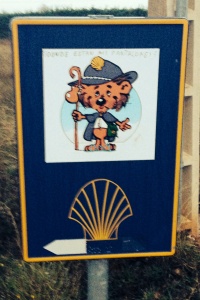
This stretch gives you options – along the highway on the official Camino francés or in the outback on an older road known as the royal camino frances! I took the royal road. I think the little lion along this path was either representing the province of León or royalty or both. Maybe he was trying to perk up my mood in the rain. Some smart ass wrote: where are my pants?
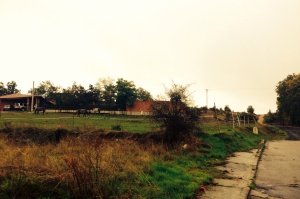
At one point I came upon this house with 3 horses right beside the Camino. I was tempted to ask to borrow one until I remembered the story of the woman on the horse on wet pavement in Logroño. The mud I walked through shortly after would have been a real problem on horseback
Now this day was by far the rainiest and coldest I’d spent on the Camino. I had only one week to go and figured I’d make do with the clothes I have, but I only had one pair of long pants and one pair of shorts. For some reason I happened to notice sporting goods stores in León and thought I’d see if I could get another pair of pants. There were quite a few days of rain being predicted. So I walked in and asked about pants, figuring nothing would fit me anyway. The woman directed me to cold weather waterproof hiking pants – not what I was looking for. I just wanted another pair of normal pants. I tried them on. They fit. I figured why not? Thankfully the spirit moved me to buy these pants because I sure was happy I had them this day! Miracle #3: pants in Spain not only fit my butt but didn’t need to be shortened! Clearly I was doing something right!
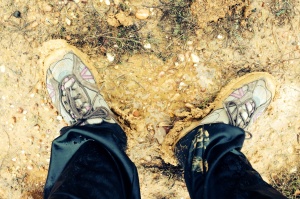
The red mud caked on my shoes very badly this day. Luckily it was a short stretch that had this kind of mud. I saw a cyclist get stuck in it
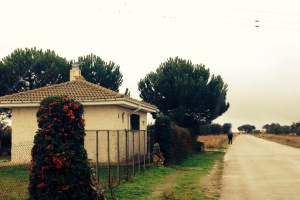
At one point I saw these shoes flung up over the power lines outside a farmhouse. Apparently someone had had enough. I knew how they felt.
I finally arrived at Mazarife – hallelujah! The guide book claimed that one albergue had a popular bar and restaurant attached to it. I really didn’t want go out in the rain again! Hello Tío Pepe! Plus, how could I resist a name like that?! (For those who don’t know, Tío Pepe is a popular brand of sherry with a cute logo – guy with guitar)

My room ended up being that one in the front right by the flags. I think I got a girls only room tonight with only one German woman in it! The bar had challenges. Just as I finished lunch, water began pouring over the bar coming from the ceiling! Is it raining that bad!? Turns out someone was taking a shower upstairs and there was a plumbing problem. Either way, not great news. Time for a fourth miracle
Preconceived Notions and Cranky Yankees
Not so sure why I’m so focused on presenting the 3 Brazilian Stooges – perhaps because it’s the last time I really felt connected to other pilgrims. Not just them, but others at this albergue from two nights ago. I’ve already written about Población de Campos, but apparently my time there impressed me more than I realized. Or maybe it’s been a couple of not so fabulous days since then.
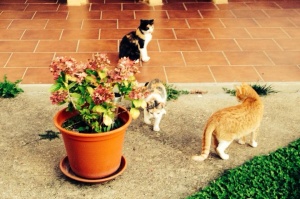
The neighborhood kitties come running when people snack in the courtyard of the hotel. The innkeeper said that only one belonged to the hotel and she’d be happy to let you take any of the others
That night at dinner I sat with a woman from New Zealand (born in Germany) a Swiss guy, a couple from England, an Australian, and a couple from France. The conversation switched between French and English as the New Zealander spoke good French and I could manage in it, while the French couple really spoke no other language. There was also a Japanese man and 3 people from the Middle East who sat apart from us. Only three of us were staying in the albergue, the rest in the hotel. It surprised me that more people from the albergue weren’t at dinner – there were about 20 there and there weren’t lots of choices in town. It was their loss as the paella was great and the woman had made us a special cake and we got a bonus after-dinner drink.
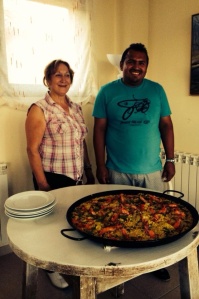
The innkeeper and her assistant made a beautiful paella for dinner. Dinner was in the hotel affiliated with the albergue. The hotel – albergue complex is very common. The albergue was in a former school next to the hotel. Too bad more pilgrims didn’t take advantage of this dinner.
Earlier that day – while passing through Frómista, I’d learned about a couple from New Hampshire. I’d stopped at the tourist info office and he asked where I was from. When I said Boston he explained that a couple from New Hampshire had just passed through and were close ahead of me. Since I was alone I thought I’d say hello. When I caught up to them the man was in a store and I said hello to the woman, explaining I was from nearby Boston. Her first words to me were: “one of your senators is trying to get rid of ours” (Scott Brown’s recent move to NH to run for senate) I learned they lived in Dover – not far from UNH – and that was about all. They moved on like they had no interest whatsoever in talking with me. A “neighbor” several thousand miles from home traveling alone. Nice to meet you!
At dinner I was with people from just about everywhere, all ages, all accommodating one another. The Australian, who was traveling with the British couple, not on the Camino, seemed particularly interested in learning more. The New Zealander shared with me that she’d met two German girls on horseback on the Camino. She ran into them behind the cathedral in Burgos! That had to be quite a sight! Their parents were traveling along with a car and trailer supplying hay for the horses!
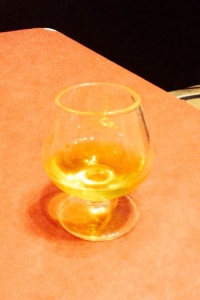
This Saturday night seemed quite exceptional. We had a specially made cake for dessert and a bonus after-dinner drink of orujo, a local liquor. She explained the hotel was only a few years old and both her husband and father passed in the same month around the time of its opening.
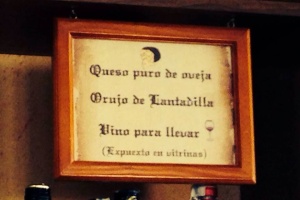
I’d never heard of orujo until the night before and here they were selling it at the first cafe where I stopped the next day!
Circumstances of distances and available lodging over the next two days had me shipping my pack. Since I had to do that, I had to reserve in advance. And since there were no private albergues in Carrión I got a cheap single room in a pension with a shared bath. The upside is a good night’s sleep but the downside is being disconnected from other pilgrims. It’s ok for a night, but I don’t like going much longer than that.

Villalcázar de la Sirga was my first stop on the way to Carrion. The church was an interesting visit.
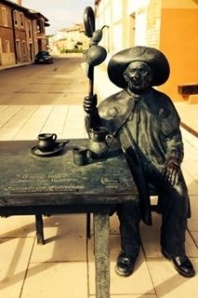
Pilgrim sculpture created to honor one of the characters known in this town, Villalcázar de la Sirga
Now the reason it was important to stay in Carrión is that between there and the next town is about 18km with only one place to stop – a luxury hotel about a km out of town. So that means stocking up on food for the journey and getting ready to go 17 km without a real rest! Once again I shipped my pack.
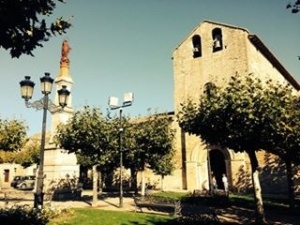
The plaza of Santa María in Carrión, a border town known for a bloody past – revenge killings by El Cid for the mistreatment of his daughters. Will have to look up more details on that one
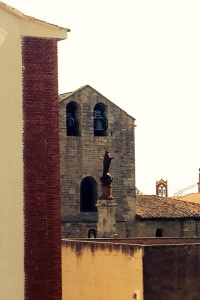
I sprang for a 15€ private room with a shared bath in a pension that night. My window overlooked the backside of the plaza
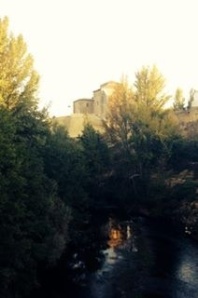
Leaving Carrión for the 18km trek with no town to stop in. Not sure what building this is, but it made a nice reflection in the river below.
From the outskirts of town to the Roman road is about 6 km. At that point you join a nice flat track that goes on for 11 km. it was a sunny day but there was a steady fall wind blowing. It had been a while since I’d walked this distance and it felt like it would never end. I stopped at the last rest area at the picnic table. Four English speakers stopped but avoided sitting with me (including the New Hampshire couple). Four French stopped and sat a bit closer (probably because there was no alternative) but not at the table with me. This was very odd – most people on the Camino are quite friendly – especially to those traveling alone. Had they all heard about Scott Brown and were offended I was from Massachusetts?!
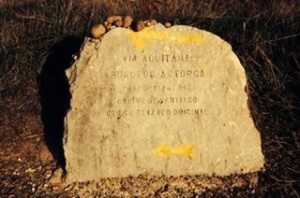
Marker saying you are about to join the path of the original Roman road. I’m really glad they covered it with gravel because the last Roman road I was on was like being on the worn cobblestone of the historic parts of Boston – not particularly friendly to feet in hiking shoes
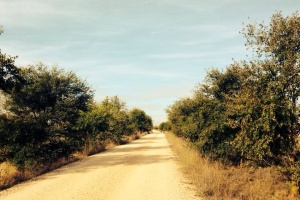
This Roman road went on for 11 km with no stops except 4 rest areas about every 3 km. I didn’t realize there were rest areas so ate my lunch in the shade of a tree before I reached the first one! I’d already gone 7 km that day!
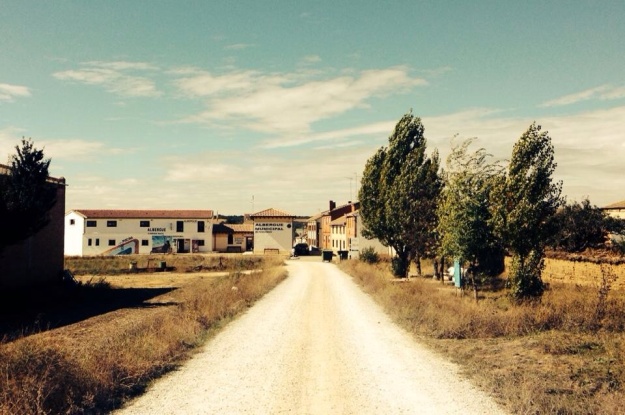
I was happy to see this albergue as I entered Calzadilla de la Cueza. I’d shipped my pack here since I was walking 18 km, against doctor’s orders!
The arrival at the next albergue couldn’t come fast enough! I check in and who do I find? The charming couple from NH! Since they were retirement age and lived near UNH I thought I’d give it one more try. I know someone who recently retired from UNH and thought it’d be a shame if they knew him and I’d never asked. This time I approached the man when the wife was not around. I told him I was from Massachusetts and his first words to me were: you admit to that?! I told him I was quite happy to admit to that! I was hoping if we had an acquaintance in common that they’d start treating me better! We didn’t! After all was done I thought to myself: this is why the rest of the country thinks New Englanders aren’t friendly!! You’re giving us a bad name! They will forever be etched in my memory as the cranky Yankees (as in northerners, not Americans nor baseball players!) Seriously, New Englanders, if you have this attitude you need to get over yourselves!! And they say people from the big bad city of Boston aren’t friendly – I beg to differ!
That night I went over to the nearby bar for the pilgrim meal. There were 3 people at a table for 4 and they let me join them. Apparently they didn’t know about Scott Brown!! There was a 30something Swiss woman, an Italian American man recently retired from the Air Force, and an Italian man who was traveling with him. They’d all already walked more than 1000 km as they were walking the Camino aragonés! They said they averaged 30 km a day. I knew this was going to be a short relationship because I wouldn’t be doing that!
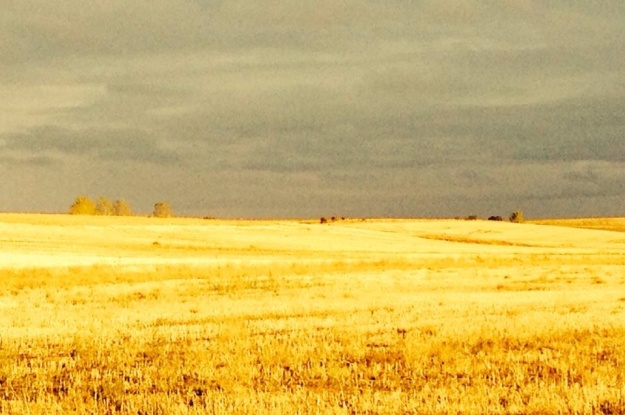
This field (wheat, I think) across from the albergue looked dramatically different each time I saw it. This was in the afternoon light – I imagine this is what the composer of “America the Beautiful” was thinking of when he wrote “amber waves of grain”
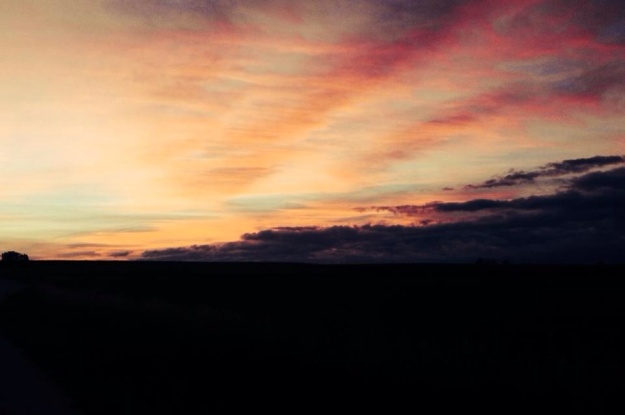
Same field in the morning light. Red sky – take warning? There’s been a constant cold wind blowing the last few days and rain is predicted for the near future
I left for Terradillos de los Templares in the morning with an overcast sky and a strong wind blowing. It had been like that for several days and the prediction for the next few days was for rain. So far I’d only had 2 mornings of it. Maybe it was time I paid my dues.
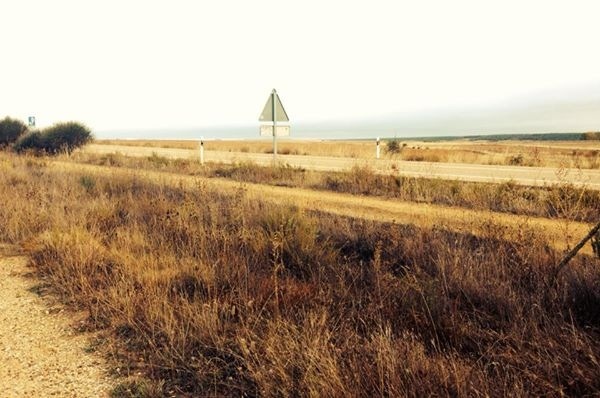
There are choices to be made when traveling from Calzadilla to Terradillos de los Templares – this one is the low road, along the highway. I was surprised to see almost everyone take it when the more scenic route was only 300 km longer (the length of a football field!)
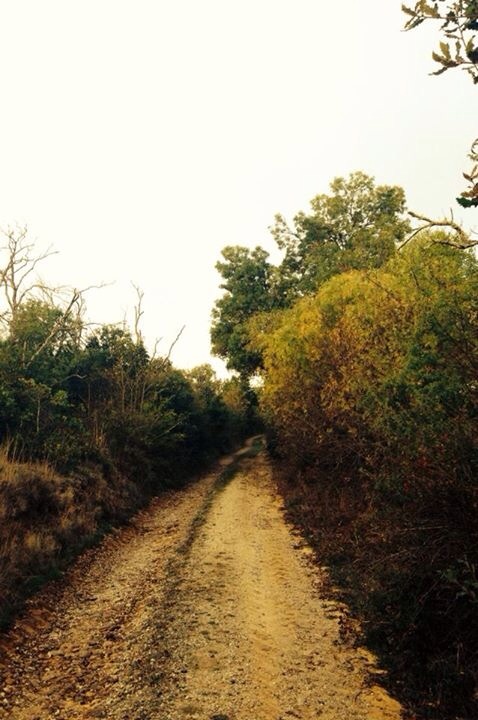
This is the high road – through an attractive wooded area with birds chirping and little animals scurrying. My only concern was that if anything went wrong, there’d be no one around to help me out since no one was taking this road!
I made it to Terradillos with no rain, but that changed overnight. Things got better here – ironically, because I skipped a crowded dinner and shared my bread, cheese and olives with 2 Korean girls who provided the wine!

Arriving in Terradillos de los Templares, at the albergue named for the last knight Templar – Jacques de Molay
I think I’ve written enough for now. I’ll leave my evening with the Koreans for my next post!
No Goal, No Deadline, No Problem
So now that I’m sticking with the 10 km-per-day plan, every day is a new day with new people. Since it takes me about 2 hours to walk 10 km, I’m always plenty early to get a bed – or so I thought. The day I walked from Hontanas to Castrojériz could not have been predicted. I left around 8:30 and as expected arrived around 10:30, but I met two people from Ireland along the way. Need I say more?
Somewhere along the road I decided I needed music so put in my earphones and listened to Trisha Yearwood, singing along. At some point before I reached the next landmark, the convent ruins, Peter from Ireland came up and commented on my singing. We struck up a conversation, which was soon interrupted by a phone call from Ireland about a farming emergency – a cow had lost a calf in the birthing process. I asked Peter how many cattle he had, just making conversation. Lessons #1 and #2 that day were to never ask an Irishman how many cattle he has or how many acres he owns. The answer is: “Enough”
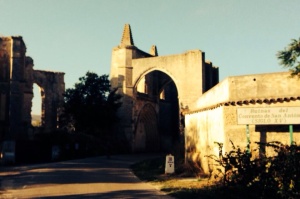
Ruins of the 14th century convent of San Antón Abad, patron saint of animals. Known for curing sickness and using the Tau (t) of the Greek alphabet as a cross. The Tau is often seen on the Camino.
I thought I’d lost Peter when I stopped to take pictures of the convent ruins. Maybe I asked too many nosy questions about cows?!
Around the time I was arriving in Castrojériz Peter and I reconnected and we both stopped for a drink at the first bar in town – he for water, I for coffee (and tortilla). At least that’s how it began. We sat and talked for a while and then Pauline, also from Ireland, walked up. I’d met her in Rabé a few nights before. All three of us had stayed in Hontanas, but in 3 different albergues. I was at my 10 km limit for the day, so I knew I was staying here. I don’t think Peter realized he would also be staying here. I’m not sure what Pauline’s goal was for that day. I was just happy to have company and conversation as I waited for the albergue to open so I wasn’t about to chase them away. Pauline managed to stick with coffee but Peter and I moved on to tinto – red wine. Lesson #3 of this day: A bird does not fly with one wing (in other words, let’s have another), courtesy of Peter’s dad.
We’d sat down around 10:30 and it was now going on 1 pm. I was concerned about getting a bed in the Refugio San Juan so we all moved on. Pauline also decided to stay here, and we both left our backpacks at the refugio, because it didn’t open til 3:00. Peter looked for an ATM. We decided to eat lunch since we had time to kill before the refugio opened. We enjoyed more tinto with lunch.
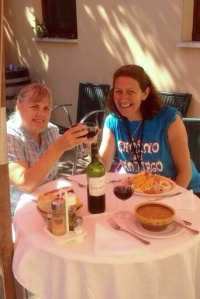
Thanks to Pauline and Peter I have this appropriate pic for my blog. If I didn’t steal this from Pauline, you’d just be seeing a table with glasses filled with partially consumed red wine
I looked at my watch. It was 3:30, maybe we should go get a bed? The refugio was only a block away.
Now Peter decided it was too late to move on so he decided to stay. The three of us arrived just as they gave away the last four beds! The innkeepers felt badly so offered us mattresses on the floor of the office for the night. Lesson #4 was drilled into me by the innkeeper: first secure a bed, then eat lunch! But why’d they have to open so late!! We were there at a reasonable hour!
Pauline was planning to catch a bus the next morning to begin the trek home to Ireland. While she went off to find the bus stop Peter and I took showers. She came back to tell us she’d found a room with a second bed, so we both moved out and left Peter to sleep on the floor (with a young Korean girl)
We all had dinner together that night. After a bit Pauline recognized that the place we ate dinner was the same place we’d had lunch – we’d just come in a different door and didn’t realize it. It really had nothing to do with the wine! The relationship that lasted less than 12 hours but felt like a lifetime. In a good way. Many lessons learned that day.
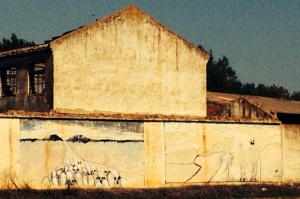
Mural as you enter Itero de la Vega, first town in Palencia. I wasn’t sure if the sheep scene was intended to be pastoral or if it was being sarcastic given all the pilgrims following like sheep
My next 10 km stop was Itero de la Vega, the first town in the new province of Palencia. I checked into the first class side of the first albergue: no bunk beds, only 5 in the room, real sheets on the bed, a towel and a bar of soap all for 10€! I was the only one there until an Australian couple traveling with a Danish woman checked in. I’d met them with Peter the previous day at our 10:30-1:00 “coffee” break!
We had an enjoyable evening/dinner and per my usual relationship, it lasted until my next 10 km stop – Boadilla del Camino – which we reached around 10:30!
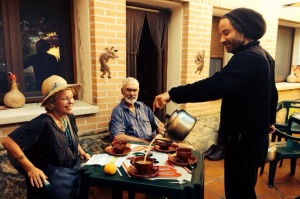
We stopped for coffee in Boadilla del Camino. I checked in and they went on. This innkeeper was one of the friendliest. He wanted to talk to me about living in Sevilla during the post-Franco days
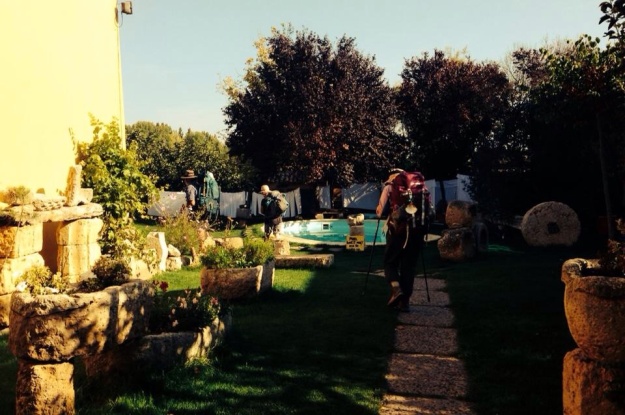
Ray, Luna, and Lynne leave the albergue En el Camino. The grounds were beautifully decorated and maintained
This albergue was recommended to me by Sarah and Parke, who’d walked the Camino in July and August. The grounds really were quite nice, with a small pool and much artwork. It was like a small haven in the center of the town.
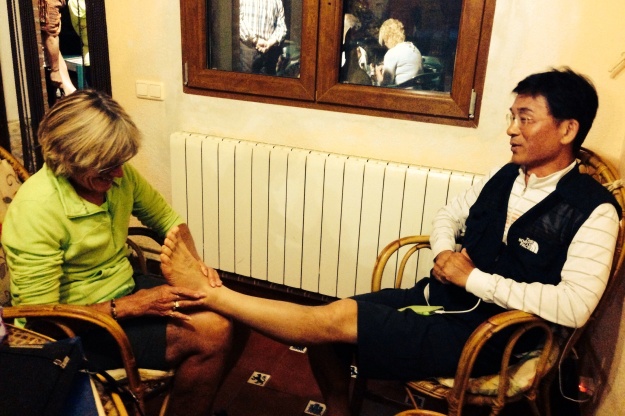
After dinner that night Karen from Oklahoma was offering free foot massages. I might have considered one if I wasn’t afraid parts of my toes might fall off!
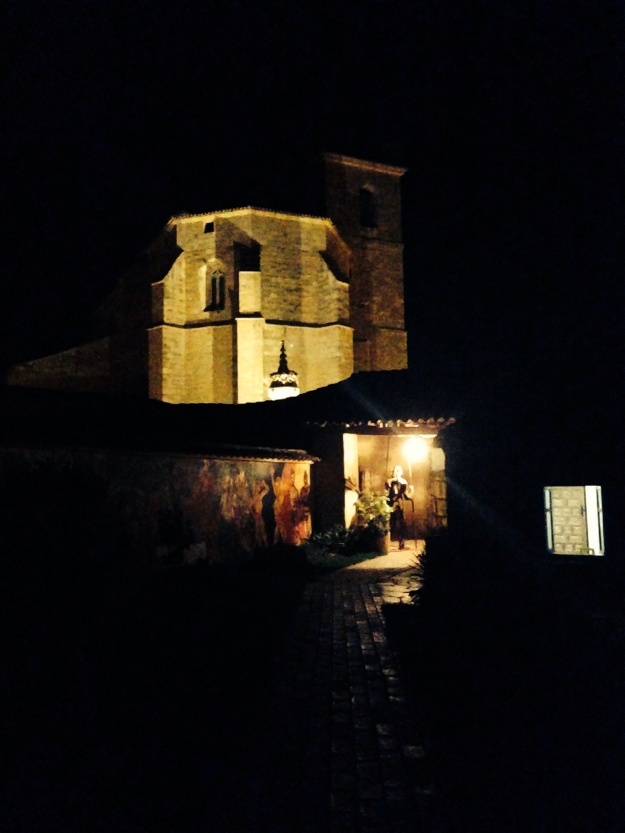
View of the church in Boadilla from the grounds of the albergue. Note another pilgrim statue in the doorway
I set out for Frómista that morning in search of an ATM, as I was down to less than 3€ in cash. I found a Santander bank, took out money, and went for second breakfast – tortilla and coffee. She didn’t want to change a 20€ bill so took all the change I had left: 2.64€ for a 2.70€ snack.
When I arrived at Población de Campos it was around 11:00 – a late day for me! There were 3 Brazilians already checked into the albergue making lunch – a huge pot of spaghetti! They invited me to eat with them and we spoke Spanish/Portuguese hoping we’d understand enough of each others’ language.
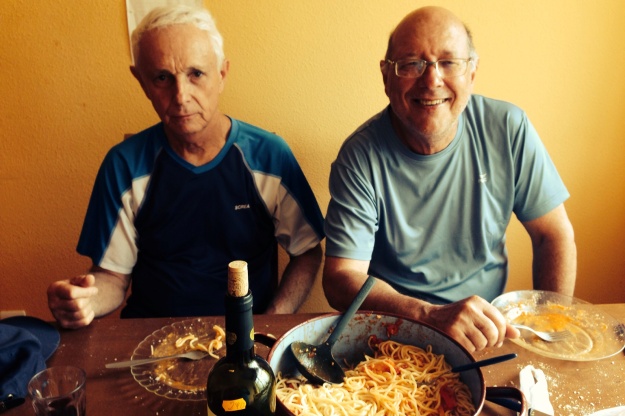
Two of the three Brazilian Stooges – that’s what they called themselves! They shared their spaghetti lunch with me and some others. They made enough to feed about 20 people!
And that’s where today’s story ends. I’m considering shipping my pack and walking 15 km tomorrow so I arrive at a decent time. We’ll have to see how that goes!
Back On The Enlightenment Superhighway (and Driving in the Breakdown Lane)
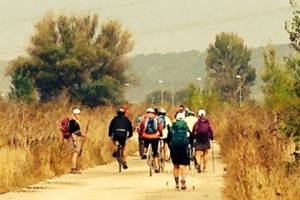
Within an hour of leaving Burgos I ended up in a bottleneck of hikers just as a group of more than 10 cyclists whizzed by. If you’re looking for solace, walk the Camino portugués, not the Camino francés (at least not in September!) A German I walked with did it last year – it’s shorter, cheaper, well-marked, and not crowded. (Oops, I wasn’t supposed to say that! Now that will get crowded too!)
I was thinking of titling this post “Rules of the Road” but I really don’t think there are rules. The road just is what it is. There are conditions and circumstances that make it more or less enjoyable. I’d say my own personal “Conditions of the Camino” are:
1. Do not walk more than 10 km a day.
2. Wear knee support.
3. Walk after the sun has risen (8 am) Depending on terrain, it’s only going to take 2 to 2 1/2 hours to walk 10 km. You can’t enjoy the landscape in the dark. And it’s easier to get lost
4. If it’s easy terrain, carry the pack. It gives you a lot more flexibility if you have your things with you.
5. Arrive early. (But not too early. Many albergues don’t open until noon)
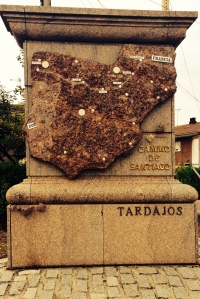
The first town I walked through was Tardajos. This map found as you enter town gives you a good sense of what I’ve walked. I started in Pamplona, not the French border!
I would not have chosen a lot of this, but ironically I think it has me enjoying things more. As a result of walking less, there are many advantages:
1. I can be the last one out, and have more room to organize my stuff.
2. I’m not in a rush. It’s hard to stretch 10 km into even 3 hours
3. I’m usually the first person at my destination, get the best bed
4. I can take a shower and do my laundry before most people show up. No competition for facilities.
5. I’m not tired so I take time to explore the town.
6. I get to know the locals because I hang out with them all day.
7. There’s a whole new group of people to meet every night.
8. More time to blog (if you have decent wifi)
#7 has its good and bad points. Sometimes you meet people you’d like to spend more time with but no one is going this pace. At the most you’ll spend the morning with them walking the next 10 km (but not if you’re the last person out the door)
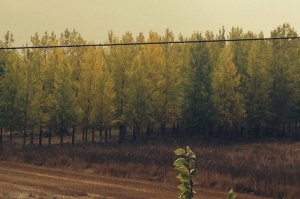
This grove of trees was on the side of the road as I entered Rabé de las Calzadas. You can see the fall color starting and it definitely feels like fall in the morning and evenings. Sun up is around 8 am and sun down around 8 pm
Tonight was the second time in 20 days where the language around the dinner table was Spanish. And the only non-Spaniards were Italian and Portuguese speakers, so they could follow a lot of the conversation. All the Spaniards were saying how much the Camino has changed in the past 5-8 years: more commercial, crowded, not very contemplative. One said that estimates were that there are currently 30,000 on the Camino francés.
The first day of walking on my rejuvenated leg took me to Rabé de las Calzadas. I had a reservation and shipped my pack, and was the first to arrive – about 20 minutes before it opened at 12:30. Three other people waited with me, including two future roommates – one from Portland OR and the other from Germany via Turkish parents. We got into a discussion about the movie “The Way” which everyone discusses all the time on this trip. My experience with this movie was finding it as a bargain basement DVD a few years ago and picking it up thinking it might be of interest since I hoped to walk the Camino one day. I don’t ever remember it being in theaters. I thought it was mostly uninspiring, although the scenery is nice. Apparently it has moved thousands of Americans (and others – apparently it showed in Germany) enough to walk the Camino. So basically Emilio Estevez and Martin Sheen are to blame for the 30,000 people currently hogging all the beds!
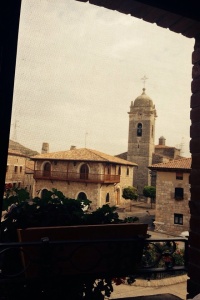
View of the church from the window in our room. There is a monasterio (convent, in this case) along the street by the church where the nuns have evening vespers at 8. We made a visit.
When I voiced my lukewarm review of the movie my Portland roommate reacted as though I’d committed a sin! This was her second time on the Camino and she felt she needed to come back to get grounded and make decisions about life. I still think this is like a mad rush playing musical beds!
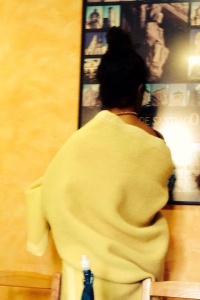
A Camino classic: wearing a light summer top and skirt while laundering everything else you own – and keeping warm with a blanket from the albergue!
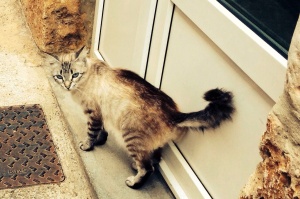
One of the few friendly kitties I’ve met – most are street cats and very skittish. This guy was sitting on the window sill while I pet him. Then he got down and waited by the door as if to say “you got to pet me, now let me in!”
Dinner that night was a little less serious. Two sisters (one now in Vermont and the other in Chicago) helped me finish off a bottle of red wine. We ended up singing traditional songs of the countries represented at our dinner table – Frere Jacques, It’s a Long Way to Tipperary, and She’ll Be Comin Round the Mountain When She Comes.
Many of us went to the evening vespers service at the convent that night. It was a bit confusing since you had to be buzzed in. You really didn’t want to show up late. After the service they did a pilgrim blessing and asked us to pray for them. Since the youngest was probably in her 60s I can understand why – if someone doesn’t join soon, there will no longer be a convent. They were very sweet as they tied medals of the virgin around our necks and gave us kisses as though we were undergoing first communion.
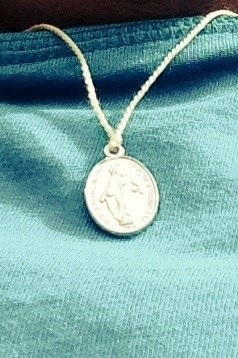
At vespers that night the nuns gave the pilgrims a blessing and gave us these medals. (For some reason all I can think of is Catholic guys in high school!) They commented on my Spanish since I could read along and told me I was nearly andaluza since I’d lived in Sevilla! It’s been a long time since I was kissed that much!
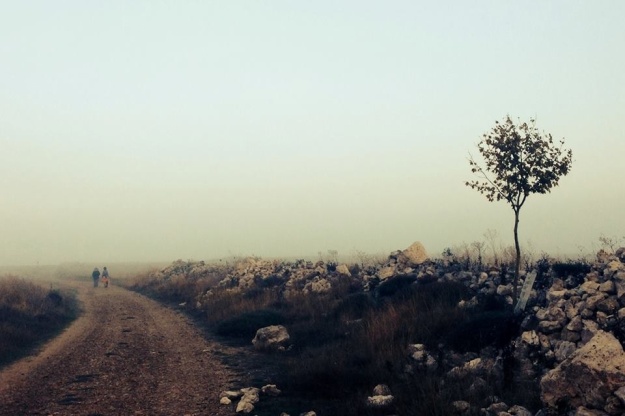
The morning we left Rabé. My plan was to leave at 8 since I was only going 10 km but I was up so early I left in the dark at 7. Between the time and the fog, it’s a miracle we saw the road. My trusty mini UMARMY flashlight came in handy!
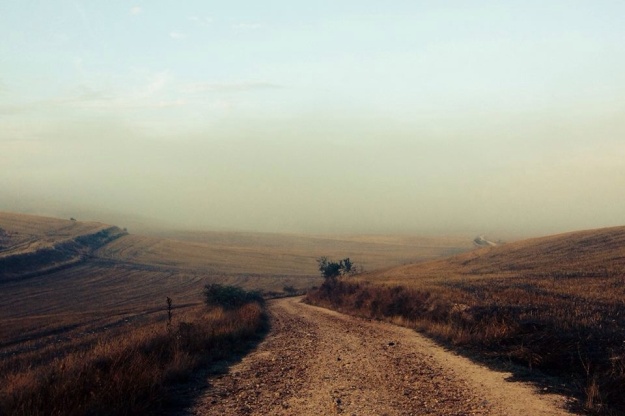
Matamulas was not as steep as I expected but there was plenty of loose rolling rock. I guess I’m glad I shipped my pack!
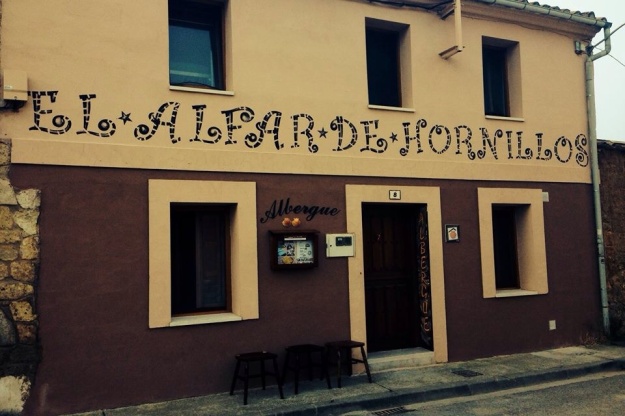
I ended up arriving at the albergue at 9:30am, an hour an a half before it opened. The only cafe/bar in town also didn’t open til 11 so they let me wait inside on the couch. I beat my backpack delivery by about 45 minutes!
The day I walked to Hornillos was an exercise in killing time. I arrived at 9:30 (see rule #1-no walking before sun up) and knowing nothing was open in town, the innkeeper let me sit in the common room as they cleaned up from the night before. They explained there was so much hair on the floor because 4 Catalans were traveling with 2 dogs – one of which was quite large! Once the clock struck 11 I knew the cafe/bar would br open, so I headed down there for second breakfast, which really turned into lunch.
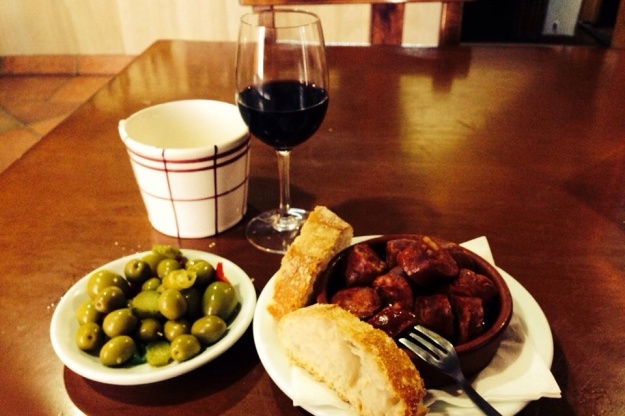
Much of the day in Hornillos I spent in the bar/cafe eating and reading and sometimes playing interpreter for those who couldn’t communicate in Spanish. The chorizo al vino and olives were yummy!
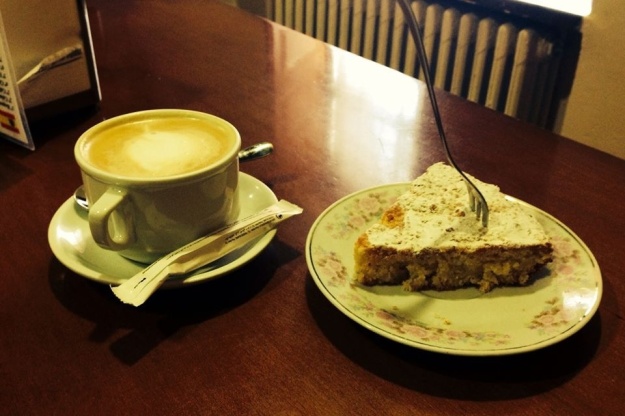
I’d noticed the Tarta de Santiago earlier but didn’t know what it was – it’s an almond tart. Luckily I had lots of time to kill in Hornillos so made another late afternoon trip to the bar for an afternoon snack! This is what gets me in trouble at home – killing time with snacks!
That night we had a communal dinner of paella and salad. One of the pilgrims was a chef from Australia. He said he usually doesn’t divulge that info. We discussed baseball, a sport he claims he knows nothing about. However, he did manage to win a 6-pack of beer by betting the Red Sox would win the World Series in 2004! He claimed when his American friend wanted to bet, the only team name he could come up with was the Red Sox!
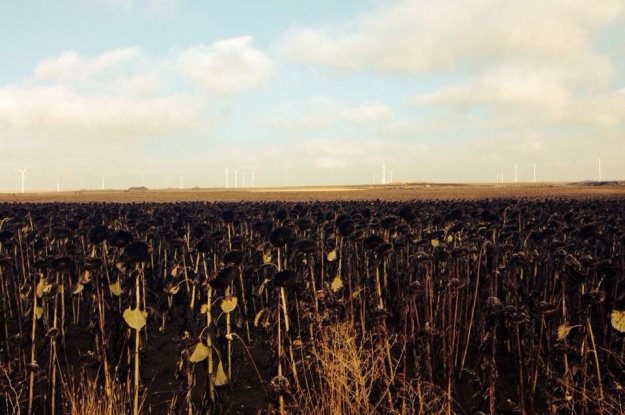
Fields of sunflowers (grown to eat the seeds) alongside windmills. There are windmills everywhere in Spain
So here I am in Hontanas in the municipal albergue. Thought I’d have my own private alcove but someone who claims she has a bad knee just moved to the bottom bunk next to me!
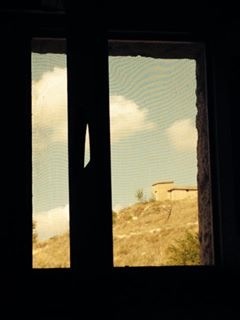
The view as I look down at my feet from my bottom bunk. There are two bunk beds (four beds) in this little alcove. At 6:30 tonight I thought it’d be my private alcove! The innkeeper assigned our bed numbers when we checked in!
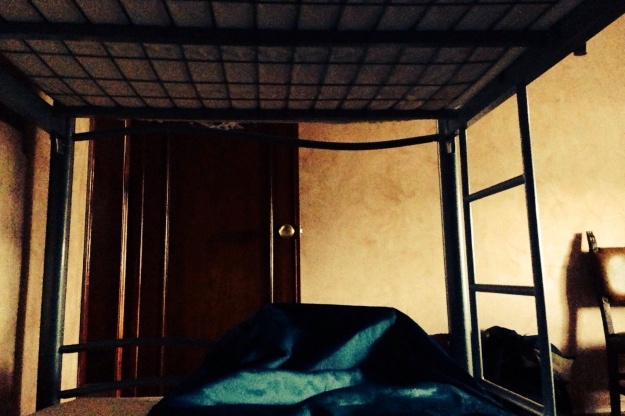
This is a more typical view as I look at my feet! And there is almost always someone in the bunk above me. It’s the last day of September. Maybe the crowds are thinning for October!
That’s all for now folks!
Seeing Burgos: Convalescent Stop
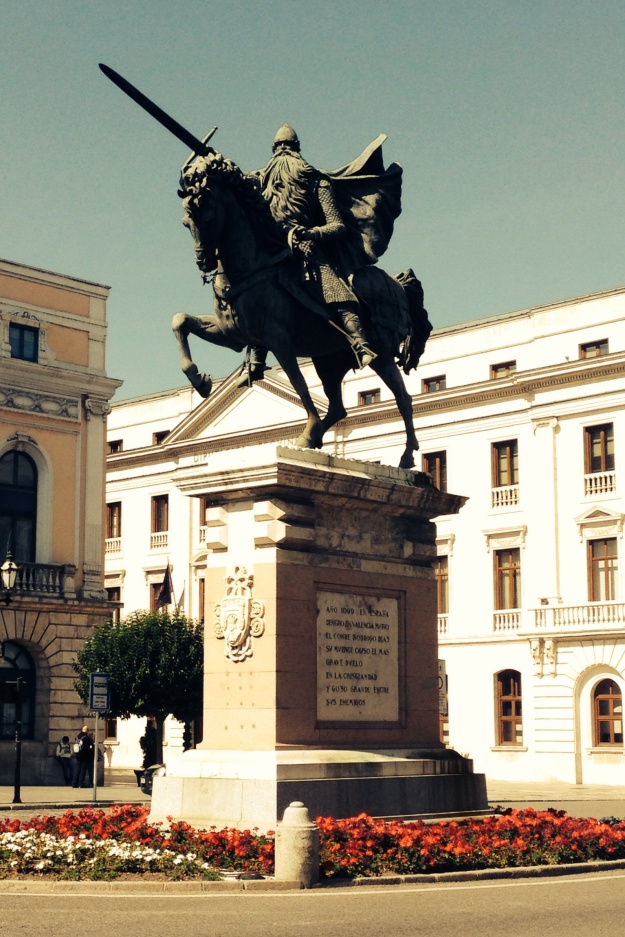
The entire town is an homage to El Cid, native son. He was basically a mercenary who fought the moors and helped Christianize Spain. He died in battle with his horse and they were buried together at a monastery outside of town (not his final resting place) I missed the monastery since I ended up taking a van ride into the city
Since I’ve spent so much time recuperating in Burgos, I thought I should at least see the city. I’d been here 20 years ago and remembered I thought it was quite picturesque, but that’s about all I remembered. I also needed to shop for a knee support and some warmer clothes for fall. It’s feeling very crisp these mornings and evenings! I also thought it’d be a good thing to test my knee while still in town.
My first day knee testing involved walking about 5 miles. I picked up some cotton socks made in Burgos at the open air market.
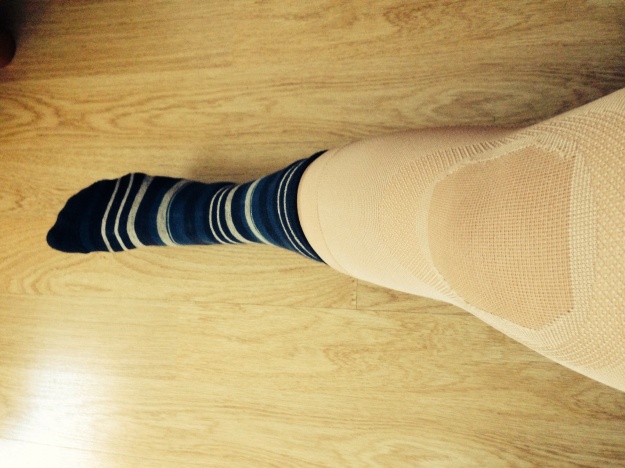
Two of my new purchases: one of three pairs of striped cotton socks and the knee support compression stocking (4.50 €, about $6)
I managed to find two T shirts, one long and one short-sleeved, as well as a “jacket” appropriate for fall weather. (An upscale, fashionable zippered hoodless hoodie designed for women so it fit pretty well) Unfortunately I could not find a pair of pants that fit well so I’m hoping my 1 pair and 1 pair of shorts last! At least til Castrojériz where I understand there’s a decent sporting goods store.
Having walked about 5 miles and completed almost all of my shopping, I thought it would be best to rest my knee. Technically this should be my third day of rest – unless you count the van ride day, where I spent half of it riding around waiting to be seen in the emergency room! I got a box at the post office to ship home some things I could live without now that I was adding warmer clothing.
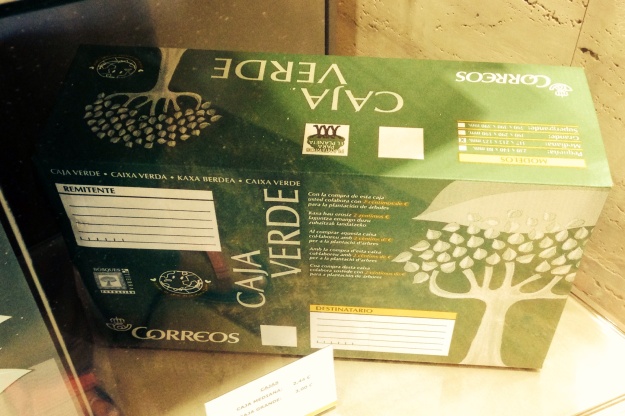
I was able to fit about 4 lbs of clothes/stuff that I could live without in this box. I’m sure the new clothes would add most of that weight back to my pack!
On Day 2 of my knee test I brought my box to the post office and logged another 4 miles – with knee support. I carried my guide book with me and decided to follow the Camino back to my hotel, seeing historic Burgos in the process. I’d walked the alternative “green route” along the river the day before.
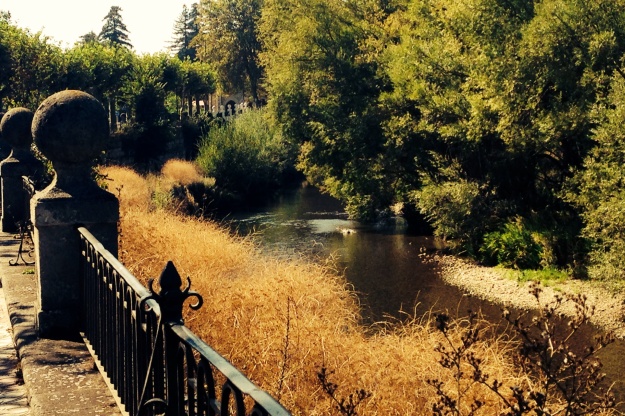
The walk along the river is given as an alternate route in the guide book. It goes right past my hotel.
Having taken the “scenic route” the day before, I decided to take the historic one. Ironically I found it to be as scenic, or perhaps more so.
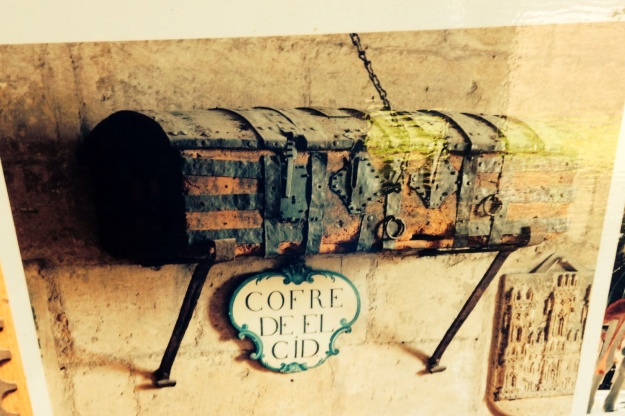
If I’d gone inside the cathedral (which I’m sure I did 20 years ago) I’d have seen the final resting place of El Cid and wife. When I learned they didn’t move his interred horse from the monastery along with him I just figured it wasn’t worth the price of admission. It’s all about the horse, after all!
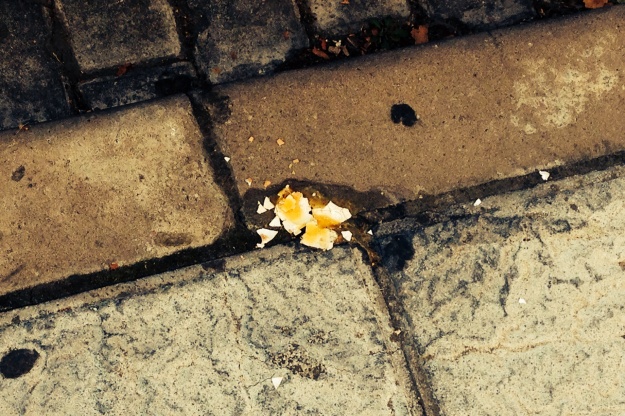
When I got close to my hotel I was reminded it was in the neighborhood of the university. This egg has been on the sidewalk since the day I arrived. Some kind of hazing with raw eggs and flour was going on that day. I was lucky to avoid being hit.
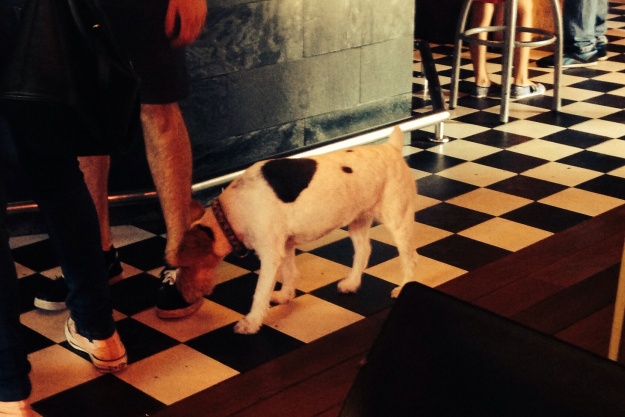
At my daily lunch stop – the bartender told me her kids wanted to walk the Camino and they did 40 km each of 3 Saturdays! But she pointed out they weren’t carrying packs. This guy – a patron’s dog – was very interested in keeping the floor clean. I asked the bartender if he was hers and she said although she liked dogs, she was plenty busy with 3 kids, a husband, and a bar!
Well, the knee seems to be behaving. It should be up to 10 km a day on flat ground. That shouldn’t take much more than 2 hours. Guess I’ll just have to see what happens tomorrow! Drop me a line if you have a minute!
To Walk or Not to Walk?
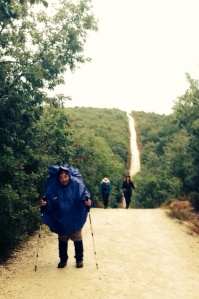
On the road to Burgos with Gloria, who had every imaginable drug, medicinal supply, and hiking aid known to man!
After an extra day’s rest I left the abbey in the hopes to make it to Atapuerca that day – about 18.5 km, which in normal conditions would be a piece of cake. These weren’t normal – it was my first true morning of rain and we were walking through red mud where mushrooms were being cultivated. Plus, we had 3 significant hills to climb and descend. I’ve never had mud cake so badly on my shoes before. Of course, at home I would think you’d have to be an idiot to hike that trail in those conditions – with a less than stellar knee. Gloria considered herself the turtle of the Camino and warned me she’d be going slowly. She didn’t know (nor did I) that she’d end the day walking with an invalid!
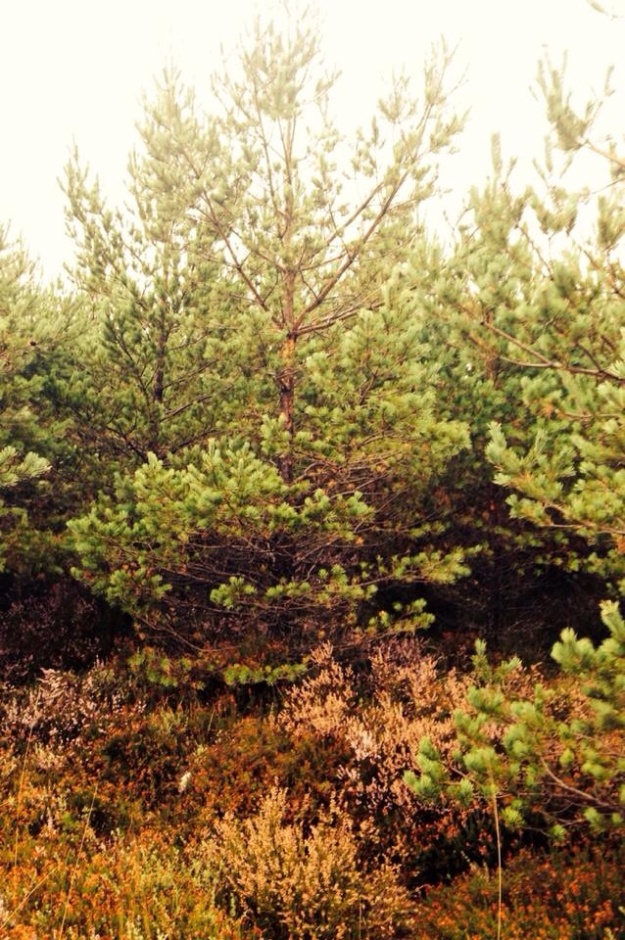
This was the first day of walking through a heavily wooded area. It was rainy and we saw heather along the road.
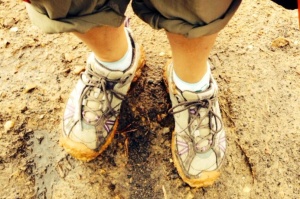
This picture does not truly illustrate how caked with mud my shoes were. It was work getting most of it off and 3 days later the shoes still aren’t clean! Luckily I have lots of time in Burgos to clean up.
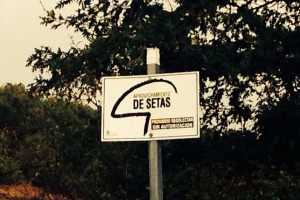
The area was filled with signs like this one. It was a mushroom-growing region and it was prohibited to remove mushrooms from the area without a permit.
The town before Atapuerca was Agés – it was about 2.5 km closer than I’d hoped to get that day. But my knee wasn’t feeling great and it was 1:30. We were finding that many albergues would be full by 2:00 due to the traffic jam of people. So we stopped in Agés. The beds to the albergue were a climb to the upper floor.
My knee was feeling bad, but I was walking on it. The banister on the stairway helped me take some weight off the right knee. I laid down a while and then went to take a shower. By the time I was finished I was worried that I wasn’t going to be able to get out of the shower. The pain in my right knee made me feel certain that surgery was going to be needed. There was a line about 6 people long waiting for the shower! Thank God there were at least two showers!
By hanging on to the many bunk beds I was able to get back to my bed. I was fortunate to have a table and chair next to my bed for support. I’d later be using the chair as a walker to get me to and from the toilet. My next concern was the fact that we’d bought dinner and breakfast downstairs and I was sure they were going to need to use a crane to carry me down there to eat!
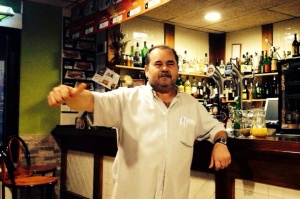
The innkeeper at the Agés Municipal Albergue. He was concerned I’d break his chair when I used it as a walker after dinner. He was instrumental in getting us a shared van to get to Burgos. Great guy.
I was lucky to be traveling with Gloria, a Canadian trained nurse. Although an American living in Seattle, she’d lived 20 years in Canada and did her training there. She was carrying Canadian Tylenol – the kind with codeine in it! I’d already taken ibuprofen at prescription levels but she said it was no problem alternating acetominophen with ibuprofen for maximum pain management. So I was enjoying it all – especially the codeine!
Now the test – could I get to dinner? I absolutely hate making a scene but I knew this was going to be one. I could get downstairs because of the bannister, but getting into the dining room would be impossible without a chair as a walker. Talk about a scene! And then once inside the waiter had the nerve to ask us to change tables, since we were a party of 4 at a larger table. Our party included Ray and his Filipina wife, Poora. After dinner she suggested I lean on Ray to get out of the dining room but believe me, I needed something more solid than a human being! Once we were upstairs she prayed over my leg, which helped, because when I needed to get up in the middle of the night I managed to move without a walker! Even better, I could get downstairs in the morning. There was a group of young Spaniards there asking about my leg – one had been cracking everyone up the night before when he tried to put his enormous rain poncho in a tiny sack! I told him I appreciated the comic relief. Although he spoke catalán he was mostly using castellano – I told him he had to continue in castellano as I didn’t understand catalán and I needed the comic distraction.
The other annoying part of all this was that I had to run a gauntlet of middle-aged French people to get to the bathroom. They were quizzing me about all of it in French and said I looked like I was walking fine on the road. So now I had to be polite in French when I basically wanted to crawl in a hole! How much torture must one endure on the Camino? I didn’t undertake this with a plan to do penance!
Gloria had walked the Camino before. She had planned to hike to the highway and catch a bus into Burgos because the suburbs were so industrial and not particularly attractive. She ended up with a door to door van ride from the albergue to the hotel I’d booked for two nights.
Gloria set out to explore the city as I took a taxi to the University Hospital (brand new, 2 years old). Time to test the wonders of socialized medicine. I explained I’d pay – they said I wouldn’t. They took my insurance info and address and said if they had any problems they’d notify me by mail. After a short wait for triage, then an exam, I explained to the doc that I was done with the Camino, what did I need to do for my leg? Surgery ? He told me I had tendonitis and needed bed rest for 3 days – elevate the leg. The nurses put a compression bandage on it that was to remain on for 3 days. Then what? He said I could continue walking, but with a knee brace and no more than 10 km a day. Should I carry my pack? He said to see how I felt! Seriously, I thought surgery would be required! I asked why so much pain between the femur and tibia right in the middle of the knee. He said I was compensating for the tendonitis and the meniscus was irritated!

With the help of a taxi Gloria and I made it to the center of Burgos for dinner. The melon with jamon serrano was delicious! Gloria had the Castilian soup – dropped egg in tomato-ey broth
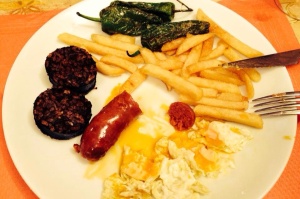
Traditional regional dinner of roasted peppers, salchichón, morcilla (yes, Imelda, like Irish black pudding), fried egg and potatoes. We shared Burgos cheese with membrillo (quince) and whiskey cake (more like whiskey ice cream cake) for dessert
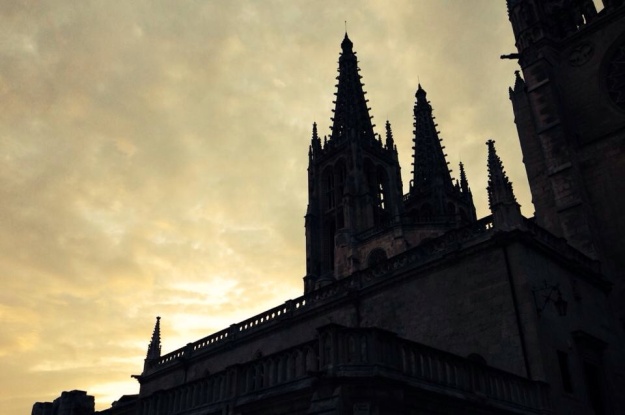
Burgos cathedral as the sun goes down – it is feeling like fall now. Will have to shop for warmer clothes
So, thinking I could no longer walk, I devised Plans C and D. (Plan B involves a reduced rate Camino.)
Plan C: ditch the north for Sevilla – I wouldn’t have to buy fall clothes!
Plan D: apply to be a volunteer at Vaughan English (I did, they’re full for Oct 5, the only date that works with my itinerary. I’m on a wait list for last minute cancellations)
Looks like I’ll be attempting Plan B – Camino at 10 km a day. I’m finishing my third day of rest today, planning a day of shopping on my feet in Burgos tomorrow, and will see how the Camino goes on Saturday. Only time will tell what happens!

